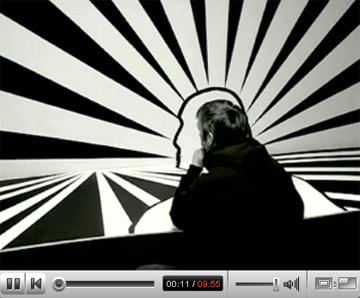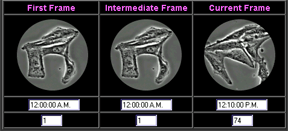July 06, 2007
Nina Czegledy reports on Media Forum 2007
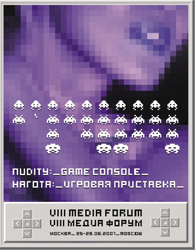
Nudity:_Game Console_
Between June 25-28, Media Forum, Moscow in collaboration with the Moscow International Film Festival, presented Nudity/Game console - a series of events including a Vito Accoinci retrospective, round table discussions and a video art competition. The theme of this year was: Nudity/Game console. The ERA Foundation hosted the Media Forum events in their centrally located, elegantly renovated gallery space.
In this report I would like to focus on the round table discussions - especially as the majority of the presenters happened to be women working with research & practice in digital fields/communities. Instead of lengthy descriptions, links are provided below for further information.
"Cultural cooperation online", the first discussion on June 26th was presented by Angela Plohman, content developer of Labforculture. The organization provides extremely useful tools for those in the arts who wish to collaborate across borders. The constructive, practical value of this information and knowledge platform was very much appreciated by the audience as attested by the numerous questions and comments.
On June 27, Anne Nigten of V2 lectured on "Research and development in the interdisciplinary field from an art perspective" followed by Dmitry Bulatov on "The third modern - denuding the media. The technobiological art work." Last but not least Margarete Jahrman showed us "Pong Dress" and Ludic Society. All of these presentations were very well received with lively Q&A periods.
Next day, June 28, "Super-Embodiment of Woman Artists in Media Arts" was presented by Irina Aristarkhova, Nina Czegledy and Elena Kovylina. Irina noted in her introduction that "Nudity and the Nude - have become key issues in contemporary art, theory and politics. Women artists face what Foucault called 'hysteriarization of female body', while men artists face an issue of 'absent male body' (Kelly Oliver) and respond to it with various strategies. One might argue that both Western and Eastern European women artists have exhibited 'too much body', and to a certain extent find it difficult to leave "body" behind. However, we rarely discuss what impact socialist gender policies and practices have had on this process within aesthetics. If performance art leaves us with legacy of 'too much body' - 'super-embodiment', - one wonders of it morphs into (new) media art as question of 'machine' / 'cyborg' embodiment and its identity."
In the course of our presentations both Irina and myself emphasized that feminism and gender issues can not be separated from the particular history of the region. Lack of clarification of this issue leads to numerous misconceptions and miscommunication. Case histories of media art were presented including "I am a robot" by Boryana Dragoeva Rossa (Bulgaria) and "Reality Resonance" by Erika Katalina Pasztor (Hungary), followed by the outstanding Russian performance artist Elena Kovylina, showing her "Pick a Girl" video performance featured at the Sydney Biennale 2006. The questions and comments at the end of our panel revealed that controversy and strife are still embedded in this discourse.
The schedule left room for us to visit some artists studios, participate in the mega-retrospective by Oleg Kulik and Vinzavod and old factory converted into a mixed use art center and luxury boutiques - where hopefully the Media Art Lab will have its future home. There is so much more including Art4 the private contemporary art museum, Moscow Rolls Royce, the electroboutique, traffic jams, night life etc. etc -worth a visit!
nina [via Spectre]
Posted by jo at 10:37 AM | Comments (0)
June 27, 2007
Tina Gonsalves' "Feel_Insula"
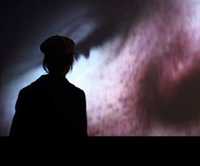
Stillness, Emotions and Hypnosis
Tina Gonsalves' Feel_Insula: An interactive Installation about Stillness, Emotions and Hypnosis :: At New Greenham Arts, The Corn Exchange, 113 Lindenmuth Way, New Greenham Park, Newbury, Berks, RG19 6HN UK :: Preview: Sunday 1 July 2007 12-2pm :: From June 28 - August 3 :: 10am-5pm; Thursday (10am-8pm; Saturdays by appointment).
Feel.Insula is an intimate and vulnerable responsive video installation driven by the stillness of the audience. In a darkened space, a video is projected on the wall. It is of the artist under hypnosis. Under hypnosis, the artist is asked to re-experience potent emotional memories of her life. As soon as the viewer enters the space, the artist wakes up from hypnosis. Only after the audience is completely still does the video fall back into weaving the stories re-lived under hypnosis. FEEL_INSULA emerges from a collaboration between neuroscientist Dr Hugo Critchley and artist Tina Gonsalves, and was created over her artist in residency at the Institute of Cognitive Neuroscience at UCL, London.
Emotion expression databases such as Karolinska and Ekman databases are commonly used with in affective neuroscientific experiments. The artist started to question the validity of these performed emotions as stimuli. In the search for more authentic emotiona; expressions, she began working with Dr. David Oakley, the Director of the Hypnosis Unit at UCL. She asked Oakley to hypnotise her in order to re-experience different potent emotional memories. Over 3 one-hour sessions, Oakley induced her into states of fearfulness, sadness, happiness and calmness. Each session was recorded using two 3 chip digital cameras focused on the artists face and also radio mic and ipod recorder. These video and audio recordings formed the basis to FEEL_INSULA.
Tina Gonsalves (AU) is currently honorary artist in residence at the Wellcome Department of Neurology at University College London. Combining diagnostic imaging, biometric sensors and mobile technologies, her installations, films for television, and software investigate emotional signatures both within the body and among interactive audiences. Since 1995 her work has shown internationally at venues including Banff Centre for the Arts (CA); Siggraph (US); International Society for the Electronic Arts 2004; European Media Arts Festival; Institute of Advanced Media Arts and Sciences (JP); Australian Centre For Photography, Sydney; Barbican (UK); Pompidou Centre (FR), Institute for Contemporary Art, London; and Australian Center for the Moving Image, Melbourne. Her music videos for Universal, BMG, EMI, and Festival Mushroom Records have been televised worldwide.
Posted by jo at 12:42 PM | Comments (0)
June 26, 2007
Movie Cards
Movie Cards is a unique workshop project by MIYABARA Mika and SUGIMOTO Tatsuo. They are interested in the generation of a creative community and the relationship between society and media. At the workshop, every participant is able to edit video easily. The system consists of the real cards made of paper. Each card is represented of a piece of video scene. Participants could get the way of thinking creative and critical through the process of making video with others. The finished moving images would be a new alternative independent media. It is a simple video editing tool and no need of any technical knowledges. It is useful for understanding and learning the expression of moving images. It can be use for media study class. Students will become conscious of the force and effect of editing. They could understand daily visual media are edited with someone's intention. Moving image media are daily thing. But we can access them as only viewing. It was one-sided relationship. Now, we can really make moving images and become a alternative filmmaker. [via mediateletipos]
Posted by jo at 11:42 AM | Comments (0)
June 25, 2007
Vernacular Video
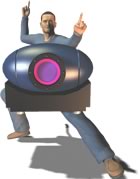
... a gift economy in an economy of abundance...
Vernacular Video by Tom Sherman: The technology of video is now as common as a pencil for the middle classes. People who never even considered working seriously in video find themselves with digital camcorders and non-linear video-editing software on their personal computers. They can set up their own “television stations” with video streaming via the Web without much trouble. The revolution in video-display technologies is creating massive, under-utilized screen space and time, as virtually all architecture and surfaces become potential screens. Video-phones will expand video’s ubiquity exponentially. These video tools are incredibly powerful and are nowhere near their zenith. If one wishes to be part of the twenty-first-century, media-saturated world and wants to communicate effectively with others or express one’s position on current affairs in considerable detail, with which technology would one chose to do so, digital video or a pencil? - NOEMA.
Posted by jo at 11:38 AM | Comments (0)
June 19, 2007
V.O.S.T.
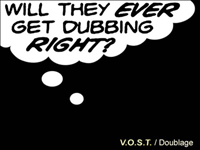
Dubbing/Doubling
V.O.S.T. / Dubbing: video works and video installations about and around dubbing :: June 24, 2007 :: Installations : 5:00 - 8:30 PM :: Video projection and performances: 8:30 PM @ Cinima de La Ginirale, 10-12 rue du giniral Lassalle, M0 Belleville.
The event V.O.S.T. / Dubbing presents video works and video installations that adapt dubbing as a form, that explore the nature of dubbing, but also notions of doubling and the double that impact the relationship between language, image and sound. Installations by Cicile Bicler, Pierre Bismuth, Frederico Camara, RYbN, and Anri Sala; Video projections by Christophe Atabikian, Nicolas Boone, Alexis Chazard, Matthieu Clainchard, Marie Daubert, Yan Duyvendak, Flatdog, Jimmy Owenns, and Michakl Sellam; Performances by Michakl Sellam, and Gwenola Wagon; and Documentary by Cicile Bicler, Alexis Chazard, Maja Drzewinska, and Fanny Martin.
The V.O.S.T. sessions are organized by Alexis Chazard (Cela Etant) and Marika Dermineur (Incident.net). Thanks to the artists, La Ginirale, Mains d'uvres, Ars Longa, Florence Brissard, galerie Chantal Crousel, Vidioart.ch and Cosmic Galerie.
Posted by jo at 10:17 AM | Comments (0)
June 08, 2007
glich-gen by DreamAddictive lab
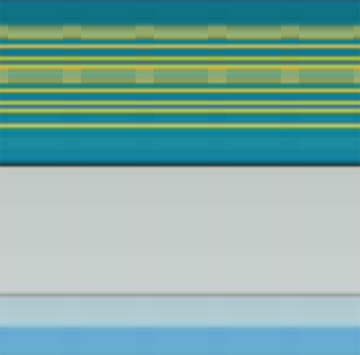
glich-gen by DreamAddictive lab :: Glitch is the digital deconstruction of an image that suffers a rupture in its source code, this rupture is known as a system error. Glich-gen uses a series of errors processed through a source code in actionscript 2 in order to generate computer animations based on image errors.
Posted by jo at 11:19 AM | Comments (0)
June 01, 2007
UNIQLO MIXPLAY
Go here to mix your own dance and sound.
Posted by jo at 05:47 PM | Comments (0)
May 29, 2007
LightHive
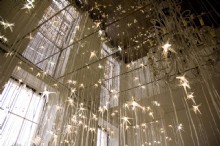
Renders Transparent What Was Once Concealed
LightHive, an installation by artist/architect Alex Haw :: Architectural Association :: until Saturday June 2, 2007.
LightHive occupies the entire main block - 5 addresses, 5 storeys and 160 rooms - of the institution's home in Bedford Square. A vast distributed network composed of various types of camera, infrared and wireless sensors relay back to a central exhibition space, where the communal activity of the school illuminates a scale model of its own light sources. Each light source is custom scripted and generated from the spatial and luminous parameters of its original source, and activated in real time by occupancy, contributing to an immersive form of spatial, 3-D surveillance. The installation renders transparent what was once concealed, compensating for the optical restrictions of the very object of the school's study: architecture.
Appearing as a spatial extension of the existing Front Members' Room's magnificent listed chandelier, its greater aim is as a self-documenting, self-recording architecture that is animated by people, resulting in a form of spatial video. It has several operational modes: predominantly realtime (which obediently varies between dynamic liveliness and patient placidity, with only intermittent signs of life), it is punctuated every half an hour by timelapse playback from its sensor database, followed by a series of fictional playbacks.
http://www.artshub.co.uk/view/ahrd.asp?Id=158989&ref=admin
http://www.kultureflash.net/current/#event4500
Posted by jo at 11:51 AM | Comments (0)
May 10, 2007
mech[a]OUTPUT
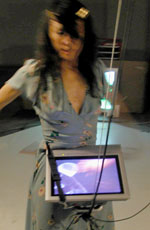
koosil-ja / danceKUMIKO
The Japan Society presents mech[a]OUTPUT by koosil-ja / danceKUMIKO :: Thu-Sat May 31- June 2, 2007.
Radical New York-based choreographer/dancer/ singer song writer/ new media artist Koosil-Ja presents an electrifying multimedia dance-performance with live 3-D environment, seamlessly incorporating elements of traditional noh music and choreography from the classic noh play Dojoji. The legends surrounding Dojo-ji Temple in Wakayama, southeast of Osaka, have inspired numerous noh and kabuki plays about the vengeful spirit of a spurned woman. By juxtaposing the restrained and subtle choreography of Dojoji with 3D world imaging projected on to a large screen, the daring Bessie Award and Guggenheim Fellowship-winning artist Koosil-ja transposes the work into her own aesthetic context, creating an innovative blend of modern and traditional, digital and flesh.
The production features 3D world designed and production by Claudia Hart, 3D Interactive interface designed and performed by John Klima, live Neo Punk Music by Geoff Matters, dramaturgy by Nanako Nakajima, Pendulum & Physical Apparatus Design and Kinetic Engineering by Michael Casselli, Head Gear by Tara Webb, and Betnon-C Bainbirdge (Video Projection Super Engineering).
With:
Geoff Matters (Live Neo Punk Music and Software Design)
Nanako Nakajima (Dramaturgy)
Michael Casselli (Pendulum & Physical Apparatus Design and Kinetic Engineering)
Claudia Hart (3D Wrold)
John Klima (3D Interface & Live Performance)
koosil-ja (Concept, Dance, Video, Video pendulum, Song, Sound Installation and Costume)
Tara Webb (Head Gear)
Benton-C Bainbirdge (Video Projection Super Engineering)
Dates: Thu-Sat May 31- June 2, 2007
Time: 7:30PM
Location: 333 East 47th Street, btwn 1st and 2nd Ave. NYC
Tickets: $25/$20 Japan Society members.
Reservations: Japan Society (212) 715-1258
at JAPAN SOCIETY Ticket Information
STUDENT RUSH $12.50 Student Rush (50% off!)
Pending availability, Student Rush tickets will go on sale an hour
before showtime. Valid ID required, 2 tickets max per ID.
mech[a]OUTPUT is made possible by a commission from Japan Society; funds from American Music Center Live Music for Dance, and New York City Department of Cultural Affairs; and generous individual contributions.
Posted by jo at 03:37 PM | Comments (0)
Wafaa Bilal: Domestic Tension
Iraqi born artist Wafaa Bilal has become known for provocative interactive video installations. Many of Bilal's projects over the past few years have addressed the dichotomy of the virtual vs. the real.
He attempts to keep in mind the relationship of the viewer to the artwork, with one of his main objectives transforming the normally passive experience of viewing art into an active participation. In Domestic Tension, viewers can log onto the internet to contact, or shoot, Bilal with paintball guns.
Bilal’s objective is to raise awareness of virtual war and privacy, or lack thereof, in the digital age. During the course of the exhibition, Bilal will confine himself to the gallery space. During the installation, people will have 24-hour virtual access to the space via the Internet. They will have the ability to watch Bilal and interact with him through a live web-cam and chat room. Should they choose to do so, viewers will also have the option to shoot Bilal with a paintball gun, transforming the virtual experience into a very physical one.
Bilal’s self imposed confinement is designed to raise awareness about the life of the Iraqi people and the home confinement they face due to the both the violent and the virtual war they face on a daily basis. This sensational approach to the war is meant to engage people who may not be willing to engage in political dialogue through conventional means. Domestic Tension will depict the suffering of war not through human displays of dramatic emotion, but through engaging people in the sort of playful interactive-video game with which they are familiar.
For the duration of May, 2007, Iraqi born artist Wafaa Bilal will live in the FlatFile Galleries in Chicago. The public can watch him 24 hours a day over a live webcam; and if they choose, visitors to his website can shoot him with a remote controlled paintball gun.
Bilal’s self imposed confinement is designed to raise awareness about the life of the Iraqi people and the home confinement they face due to the both the violent and the virtual war they face on a daily basis.
You can participate - eg shoot at him with a paintball gun - by clicking here.
See this site for some videos and more about the Wafaa's work. [via selectparks]
Posted by jo at 03:29 PM | Comments (0)
Synk
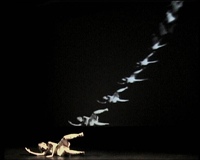
Real-time Processing
Synk is an experimental dance / video / audio piece where video and audio samples and recycles the movements of the dancer on stage, creating rich layers of images and sound. The performance deals with transformation of time ; distortion, displacement, delay, layering and buffering. The idea of Synk is that no prerecorded video or audio will be used, only material sampled during the performance are presented, to investigate live as raw material, and to impose a structure on a live situation to allow unpredictable results within that frame structure. Synk was made in 2002 and performed in a split-evening with the video ensemble 242.Pilots.
On Friday May 4th, (HC Gilje) performed Synk with Kreutzerkompani and Justin Bennett. More images from Synk (click on the small images).
Posted by jo at 02:32 PM | Comments (0)
Machine For Taking Time (2001-2004) by David Rokeby
“ A colour surveillance camera has been mounted outside the gallery on a computer controlled pan/tilt mechanism, allowing it to see most of the surrounding gardens. Every day since March 28, 2001, the system has been taking still images from 1079 pre-determined positions along a sweeping path around the garden.
[..] the computer software travels through this accumulating archive of images, wandering through time, but progressing very slowly and smoothly through the successive positions in the original path.
The software does four kinds of wandering. It sometimes moves along the path using images from a single day. Or it might disolve sequentially from day to day as it progresses along the path. Alternatively it might dissolve from date to date randomly. Occasionally it will stop its movement along the path and show all the images taken from that position in rapid succession. The shifting of modes and the choices of dates is a function of a somewhat random process, and so the piece never repeats itself.” David Rokeby.
More video documentation at YouTube.
Posted by jo at 02:12 PM | Comments (0)
May 03, 2007
the story of a never ending line
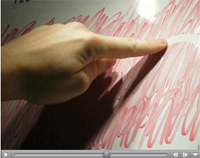
Call for Contributions
Zachary Lieberman is making a performance at the OFFF festival along with his good friend Theo Watson (of L.A.S.E.R TAG fame). The idea of the performance is really quite simple -- the story of a never ending line -- and the performance will be made up of both videos as well as live material, and synthesized graphics.
We are asking you, with your awesome brains and wicked fast design skills, to send us videos in your own style, of a line being drawn from one side of the screen to another. It can be animated, live video, computer generated, or some other way we can't even think of yet.
We would love to get videos from you to use in our performance. The more imaginative the better! All the videos used will be credited at the end of the performance so it will be a great chance to show what you can do with a line and 5 seconds of time. Multiple submissions are encouraged!
Rules:
1: The line should start off screen, enter on one side and leave on
another (doesn't have to be right to left, can be any side to any side, including the same leaving on the same side the line started on).
2: The line should have the effect of being drawn, not moved across the screen. See examples bellow.
Good: http://impssble.com/OFFF/good.mov
Bad: http://impssble.com/OFFF/bad.mov
3: Once a part of a line is drawn it should not move too much, the animation should be the effect of drawing the line (as in the good movie above).
4. The video doesn't necessarily have to be the drawing of a line (although most of what we are working with is), but it can also be something moving along a very clear path. The idea should be about going from point a to point b.
5. Both sound or silent is ok.
6: Videos should be 3 - 8 seconds long, 640 480 quicktime format. (320x240 also ok)
7: Videos should be submitted to zlieb[at]parsons.edu or theo[at]muonics.net (if under 10MB) or posted online for download.
8: We need them by tuesday 8th of May.
We hope you enjoy this challenge, and would like to take part in our project. Thanks and have fun!
zach & theo
Posted by jo at 11:52 AM | Comments (0)
April 24, 2007
URSULA BIEMANN
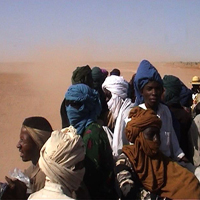
Geographies of the Migrant Bodies
TEKFESTIVAL AND QWATZ PRESENT: URSULA BIEMANN, GEOGRAPHIES OF THE MIGRANT BODIES :: May 5th-12th 2007 - Rome, Italy :: Agadez Chronicle / video-installation (Love&Dissent Gallery, opening May 5th h.6.30pm) :: 3 video-essays: Performing the Border (1999), Writing Desire (2000), and Europlex (2003) :: (Cinema Farnese, May 6th/8th): A workshop on migration and mobility (1:1projects, May 7th/8th).
It all started in Ciudad Juarez, the Mexican city at the U.S. border grown around the industrial parks managed by multinational companies with the approval of the Mexican government. Here Ursula Biemann has filmed Performing the Border (1999) and started her journey exploring the darkest sides of globalization. To describe the border, the Chicano writer Gloria Anzaldua has used the metaphor of 'nepantla', a liminal and unstable space that discloses new ideas, encounters and a feeling of uneasiness. Living in this 'tierra disconoscida' means to experience a state of unbelonging and change.
The women in Performing the Border perceive the frontier as a space of control and exploitation and, at the same time, as a space of transgression from an overbearing patriarchal structure. If gender identity is constituted through a series of negotiations and disciplinary rituals, by the same token the border is the result of the repetition of relations of belonging and exclusion that produce material and emotional effects.
Drawing on the idea that "gender and border are performed simultaneously on the border under very specific economic and spatial conditions," Ursula Biemann has realized a video-essay trilogy that, besides Performing the Border, comprises Writing Desire (2000) and Remote Sensing (2001) - a film presented at the Tekfestival 2006. The latter two films focus on the affective and sexual services offered in the global sex market after the end of the Cold War. Writing Desire's aesthetics incorporates the graphic style of the Internet through a highly fragmented editing which simulates Internet browsing. Analyzing the bride traffic phenomenon and penpal relationships, the artist shows that the Internet is the ideal space for the marketing of desire.
The contradictions of the European space - caught between the increasing circulation of goods and the closing down of the border - emerge in the last works of the Swiss artist, including Europlex (2003) and Agadez Chronicle that visualize the "movements of life" across the Mediterranean coasts. Biemann's counter-geographies show the plurality of migrants' passages. The relationship between migrants and borders is always precarious, resulting from the constant conflict between state efforts to control mobility and the people's desire to inhabit the possibilities opened up by globalization. Biemann is not interested in dealing with the romantic metaphor of nomadism. She prefers, instead, to highlight the ambivalence of migratory experiences. In her video-essay, often realized in collaboration with other artist, activists and scholars, the migrants are recognized as "political subjects" who acquire a voice in their own right.
WOP/Ursula Biemann. Geographies of the migrant bodies is presented by Tekfestival and qwatz, a new artist-in-residency program in Rome, with the support of Province of Rome and the Swiss Institute in Rome. The project is realized in collaboration with 1:1projects and Love&Dissent.
Posted by jo at 05:39 PM | Comments (0)
April 23, 2007
205A Morning Lane
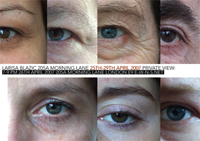
Temporary Urban Video Interventions, Architecture + Art
205A Morning Lane is a site-specific video installation using a building as a projection screen to explore possibilities of temporary urban video interventions, architecture and art. It marks the end of 205A Morning Lane studio building with two sets of visuals projected to the building's windows. First floor projection of 205A Morning Lane artists' eyes closing and second floor projection of artists' eyes opening - as eyes, window to the soul q the metaphor for cycles - endings and beginnings.
10 Video projectors are distributed in 10 artists' studios (5 on the first floor and 5 on the second) and projecting directly onto windows from inside - out thus creating two stripes of projections on the main facade. The projected material is changed on a nightly basis (five consecutive nights of projections) to play slower and slower motion so that at the end of projection all eyes close.
25TH - 29TH APRIL 2007 :: [PRIVATE VIEW: 26TH APRIL 2007 7-9PM] :: Morning Lane Studios :: 205A Morning Lane, London, E9 6LG. To get there: Hackney Central BR or busses 30, 48, 55, 106, 254; Map.
Posted by jo at 02:12 PM | Comments (0)
PAM] the Perpetual Art Machine

Three Events
[PAM] the Perpetual Art Machine Trifecta.
[PAM] TO BE FEATURED AT COACHELLA MUSIC AND ARTS FESTIVAL :: April 27 - 30, 2007 :: In its first appearance on the U.S. West Coast, Perpetual Art Machine [PAM] will be a featured multimedia installation at the Coachella Valley Music and Arts Festival, Indio, California, April 27-29.
This year, Coachella is presenting over 100 of the biggest names in music and art, including Bjork, The Red Hot Chili Peppers, Rage Against the Machine and Sonic Youth. [PAM] is putting into place its largest installation to date, at the Empire Polo Fields, a desert oasis just outside Palm Springs, for this three day outdoor 70,000 person sold out event.
Combining touch screen and projection technology, [PAM] gives its users an immersive 5 channel interactive video experience. Entering into the [PAM] installation, the user becomes the curator of some of the most cutting edge video work made this century. [PAM] democratizes the curatorial process by inviting both the artist and the viewer/user to participate on site and online at perpetualartmachine.com.
[PAM] was created in December 2005 as a collaboration between the artists Lee Wells, Raphaele Shirley, Chris Borkowski and Aaron Miller and has had installations and screenings worldwide including the United States, England, Austria, Russia, Brazil, Canada, France and Croatia.
At this year¹s Coachella festival, [PAM] will premiere its first ever compilation DVD titled "Perpetual Art Machine 2006-2007: Year one · Volume One" featuring 16 videos highlighting some (but not all) of the best work in the [PAM] archive.
For more information on Coachella go to http://www.coachella.com
For immediate assistance please call Lee Wells at 917 723 2524.
[PAM] TO BE FEATURED IN NEW MEDIA ART LOUNGE at artDC. :: April 27 - 30, 2007 :: Perpetual Art Machine [PAM] will be featured as a new media project at the inaugural Modern and Contemporary Art Fair, Washington DC - artDC. Modern, contemporary and high quality cutting edge work defines this newest art fair in America.
[PAM] will present a single channel interactive multimedia installation and will feature the artwork of Bill Dolson, Miroslaw Rogala and Raphaele Shirley. The New Media Lounge is organized by Rody Douzoglou and artDC takes place 27 30 April at Washington Convention Center, Hall E.
[PAM] co-founder, Raphaele Shirley also will be part of the New Media: Exploration and Innovations panel, which will explore the exciting area of new media, which is gaining more attention than any other medium in the current art market. The very distinguished panel of experts will discuss the topic.
Panelists include:
Peggy Parsons, Moderator,
Film Department Head of the National Gallery of Art, DC
Kerry Brougher,
Chief Curator of the Hirshhorn Museum and Sculpture Gardens, DC
Beth Turner,
Senior Curator of the Phillips Collection, DC
John Hanhardt,
Consulting Curator of Film and Media of the Smithsonian Museum, DC
Raphaele Shirley,
Artist and co-founder of Perpetual Art Machine, NYC
For more information on artDC, go to: http://www.dc-artfair.com.
For immediate assistance please call Raphaele Shirley at 917 805 6320.
[PAM] PROFILED IN VIDEO AS URBAN CONDITION PROJECT IN AUSTRIA AND BRAZIL :: Exhibition @ Lentos Kunstmsueum/Museum of Modern Art Linz, Austria :: April 19 May 27, 2007.
Screening: Fundação Clóvis Salgado/Palácio das Artes, Belo Horizonte, Brazil
April 28, 2007.
Compiled by UK artist, Anthony Auerbach, the Video as Urban Condition project explores how video shapes urban experience.
Video is a medium of mass production, mass participation and mass consumption. Video as Urban Condition recognizes the diversity of activity in the field and challenges the participant to reflect on how the relations of representation in society are mediated by video.
The project reflects on the mutability of video as it shifts between fact and fiction, entertainment and persuasion, urban fantasy and reality-TV, art and activism, surveillance and control - tracing the web of interactions between of media and architecture, subject and commodity, identity and desire, the city and its phantasmagoria.
Video as Urban Condition examines a medium whose most distinctive characteristics are multiplicity and diversity, a form, which is not contained by the norms and institutions of art nor by the exclusive domains of professionals.
[PAM] Video Pool contributing artists: Anonymous (Iraq), George Barber (UK), Luis Berrios-Negron (Puerto Rico), Chris Borkowski (US), Josephin Böttger (Germany), Wilson Brown (Brazil), DnasaB (US), G.H. Hovagimyan (US), Stephanie Lempert (US), Aaron Miller (US), Motomichi Nakimura (Japan), Pierre St. Jacques (US), Sanotes (Spain), Raphaele Shirley (US/France), Jeremy Slater (US), Endre Tveitan (Norway), Lee Wells (US)
For more information on Video as Urban Condition go to:
http://www.video-as.org
For immediate assistance please call Raphaele Shirley at 917 805 6320.
Posted by jo at 01:36 PM | Comments (0)
April 20, 2007
N3KROZOFT LTD's Aether 9
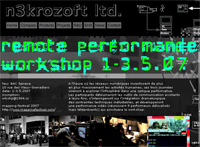
Collaborative Video Performance
the N3KROZOFT LTD media group is pleased to announce the world premiere of the collaborative video performance, Aether 9. Linking nine performers in various remote locations around the globe, this performance will occur on May 3, 2007, 21:00 CET, in the framework of Mapping Festival Geneva, in conclusion to a 3-day workshop directed by N3KROZOFT members.
Conditions of participation: [1] Participating in the workshop : If you wish to follow the workshop in Geneva: plase send an email to wrkshp[at]1904.cc describing briefly your experience and motivations (moderate knowledge and experience of video tools + originality of ideas is expected). Workshop dates are: May 1st-3rd, 14:00-18:00. Workshop location: BAC, Geneva (see below).
[2] Participating as a remote performer: Artists wishing to participate in one of the remaining performance slots: please send an email to remote[at]n3krozoft.com. Requirements for remote performers:
- You need to have access to an imaging device (webcam, miniDV camera) and a computer linked to the internet.
- Sufficient knowledge of video tools + performance is expected, to operate for instance a webcam and upload its images to a server. Server access will be provided.
- Knowledge of Max/msp or Pure Data is an advantage, but not a necessity.
- You are required to be available through skype or similar protocols for instructions and synchronisation during the days prior to the performance (1st-3rd May).
- 100% availability during the performance and at least 1 hour prior to performance is crucial.
Questions and Answers
Q - What will this look like?
A - The basic concept: 9 different locations will be linked during a 60 minute performance. The performance will be projected as a 3x3 grid of videoframes.
Q - When and where will the performance take place?
A - The performance will occur on Thursday 3rd May 2007, 21:00 (9 PM) Central European Time. The location is the BAC (Bâtiment d'Art Contemporain), 10 rue des Vieux-Grenadiers / 28, rue des Bains, Geneva, Switzerland.
Q - Is it possible to watch the performance on the internet?
A - The performance will be visible through the internet. Not directly as a video stream, but as a standalone viewer application, which will be available at http://n3krozoft.com/remote. If you are in charge of a public venue, you are welcome to use the standalone viewer to broadcast to performance to an audience. Click here to find your local performance time: http://tinyurl.com/2rjxhb
Q - Will there be any dogma/ritual imposed on the performers?
A - The content of the performance will be dictated by a formal set of rules, which will be established in part during the first 2 days of the workshop. The significance of time and the subjectivity of human experience in a specific
timeframe will be a crucial element of the performance.
Q - What technology will be used for the transmission of images?
A - To insure the possibility for performers in low-tech situations to participate, the system will be designed for robustness rather than for speed. Since streaming video needs a considerable upload rate, the transmission of images will occur rather through image-by-image upload, allowing participants to use slower transmission lines. The target frame refresh rate will be 5 seconds, similar to the transmission rate of the videophone devices in use during the 1990's. At the main performance venue, buffered playback will occur at much faster or slower framerates, depending on the performer's actions.
Posted by jo at 10:33 AM | Comments (0)
April 19, 2007
Intellectual Economy by Robert Ladislas Derr
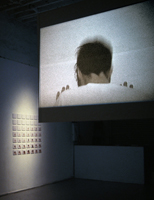
@ Athens Video Art Festival
(Athens, Greece) Robert Ladislas Derr will exhibit Intellectual Economy, a two-channel video installation in the Athens Video Art Festival, April 27 – April 29, 2007.
The act of making Intellectual Economy was as much cerebral as it was physical. The process of creating has a structure that begins with getting the idea out. Intellectual Economy physically documents the struggle endured during the creation process. It comprises of two simultaneous video projections on opposite sides of a suspended wall, displaying Derr busting his head through a wall. One projection shows the view of the wall he will eventually bust through, and the other presents the back of his head allowing the viewer to witness his act.
The installation conveys a metaphor for the thought process of creating art. The front side view of the rupturing wall echoes the process of birth and challenges the notions of illusionistic space. Breaking through the wall from one side to the other illustrates that art is not easy. While this rupture occurs on a two dimensional surface, the positioning of the projections allows the act to appear as if it is actually happening. The viewer is able to walk around this suspended wall and watch Derr’s progression.
Once the wall breaks, the art product takes form illustrating the construction and deconstruction of the art process. The breaking of the wall indicates that the act is almost complete. Derr continues to break pieces away from the wall creating a hole large enough to allow his head to comfortably protrude into the new space. After a long painful struggle to access this new space, the videos repeat the act illustrating the continuous struggle of the artistic process.
Derr derived the name for the installation after a conversation about his artwork with Michael Govan in 2001 (Govan was director of the Dia Center for the Arts at the time). Mr. Govan told Derr the he would have to be part of the "intellectual economy" before his artwork could be shown at the Dia.
Articles about Derr’s artwork:
Discipline
Void
To Helen
Posted by jo at 03:06 PM | Comments (0)
April 02, 2007
Turbulence Commission:

Urban Attractors, Private Distractors
Turbulence Commission: Urban Attractors, Private Distractors by Angie Eng in collaboration with Rich Streitmatter-Tran and a collective of student interns in New York and Ho Chi Minh City.
"Urban Attractors and Private Distractors" is a vlog project about privacy in public space in Eastern culture. It compares the results of dérives (French for "drift," dérive was defined by the Situationists as the "technique of locomotion without a goal") in Ho Chi Minh and New York City. The collective will address questions such as: How is a city constructed in a culture where the inhabitants have little experience of a private physical space? Do they adapt more readily to cyberspace which is both private / public simultaneously? How do Westerners reclaim their 'public space'? Organized dérives in both cities will commence at the most public of spaces--the town square. Participants will submit videos as urban indicators of private and/or public to the vlog until the workshop meetings in June 2007. Angie Eng, the project director, will continue vlogging until the commencement of the physical installation in Fall 2007.
"Urban Attractors, Private Distractors" is a 2007 commission of New Radio and Performing Arts, Inc., (aka Ether-Ore) for its Turbulence web site. It was made possible with funding from the Jerome Foundation.
BIOGRAPHY
Angie Eng is a media artist who works in video, installation, web-based and video performance. In 1993 she moved to New York City to pursue her career in media arts. She co-founded The Poool (1996-1999), a live video performance group, with Nancy Meli Walker and Benton Bainbridge. Her work has been performed and exhibited at the Whitney Museum of American Art at Philip Morris, Lincoln Center Video Festival, The Kitchen, New Museum of Contemporary Art, Rensselaer Polytechnic Institute, Experimental Intermedia, and Roulette Mixology Festivals. Eng’s videos have been included in digital art festivals in local and international venues in Cuba, Greece, Japan, Germany, Former Yugoslavia, Switzerland and Canada. She has received numerous grants and commissions: New Radio and Performing Arts, Inc., Harvestworks Residency, Art In General, Lower Manhattan Cultural Council, New York State Council on the Arts, mediaThe Foundation, the Jerome Foundation and the Experimental TV Center. She was recently awarded an Eyebeam residency to develop the installation component of "Urban Attractors, Private Distractors."
Posted by jo at 09:35 AM | Comments (0)
March 15, 2007
Trusted Servant by Garrett Phelan
The artist Garrett Phelan was invited and entrusted by curator Rachael Thomas and artist / curator Philippe Parreno to close the critically acclaimed exhibition '.all hawaii eNtrées /luNar reGGae' located at the Irish Museum of Modern Art. Parreno's approach, focusing on the notion of process, was to go beyond the real / physical space of the museum and as a part of this process Garrett Phelan has been entrusted by the curators to close this exhibition.
Trusted Servant also functions as part of Phelan's current exploration into the 'Formation of Opinion' (2003_ ongoing). Phelan becomes the gatekeeper of '.all hawaii eNtrées / luNar reGGae' with the removal of Trusted Servant from YouTube, at his discretion, marking the official end of '.all Hawaii eNtrees/lunar reGGae'.
Posted by jo at 01:04 PM | Comments (0)
March 14, 2007
HEATHER BURSCH: The Singer Not the Song

Between Group Identity and Self
Heather Bursch’s three screen projection, The Singer Not the Song, uses custom software to convert video into virtual, automated stadium card displays. Video of her hands moving a 15” X 20” red card to catch a range of light values is presented in a 32 X 32 grid format. The cards animate video from pre-rendered sources, referring to the card animations that celebrate unified vision in the stadiums of totalitarian states and at sporting events in the US. The mediating structure of the individual cards, as well as the moving images they collectively animate, highlight the relationship between group identity and an individual self.
Projected onto the center screen is an iconic performance of Mick Jagger at a concert in Hyde Park in 1969, just five months prior to the disillusionment invoked by the violent eruption at Altamont. Shot at a pivotal time in 20th century idealism and utopianism, this footage marks a moment in western culture that suggested tremendous possibility for social change. The side panels consist of contemporary video of public spaces, invoking a feeling of static, mechanized surveillance where individuals move quietly through institutional spaces.
The center and side screens function in opposition to each other, both positioning the viewer as a member of a unified crowd and as a detached surveyor of the other. This attempts to ask, what can the viewer’s position in relation to media of the past and the present suggest? How do these various ways of seeing ourselves reflect who we are as individuals and members of a larger cultural matrix with assumed, shared beliefs? And how do we as viewers participate in the generation and dissemination of cultural messages? The title, The Singer Not The Song suggests a double reading. The iconic image of Mick Jagger as auteur and vehicle for a social message is rendered mute, actively replaced by the transmitting framework of the crowd and recording device of the camera.
Heather Bursch, born in 1971, lives and works in Los Angeles, CA. She received her BFA in painting from the San Francisco Art Institute and is currently pursuing an MFA in Experimental Animation and Integrated Media at the California Institute for the Arts.
Posted by jo at 08:51 AM | Comments (0)
February 27, 2007
Eric Schuldenfrei
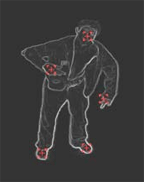
Reciprocity
“In the world of surveillance, the architecture of systems has effectively replaced architecture.” Eric Schuldenfrei
I was introduced to the work of Eric Schuldenfrei recently by Eyebeam Resident Jennifer Broutin. Schuldenfrei’s work focuses on the evolving relationship between animation, architecture, and art and has a diverse portfolio of projects that I couldn’t hope to all cover. Instead I will just cover one of his video pieces ‘Reciprocity‘ because of my own personal interest in reciprocal environments which I explored with my installation ‘Reciprocal Space‘. To look at more of Eric’s work visit his portfolio website.
Eric describes how “Theories of reciprocity… are used to describe relationships, mutually beneficial actions, situations of give and take, influence, correspondence, cause and effects within social structures. In reciprocity a relationship forms between those who operate and develop surveillance systems and those under surveillance.”
“Automatic digital collection systems and linked databases create highly contested spaces, raising questions of both security and privacy. Control is no longer conceived through building sections, plans, or perspectives, instead it is envisioned as a spatial construct in real-time, fully automated systems happening ubiquitously.” [blogged by Ruairi on Interactive Architecture dot org]
Posted by jo at 10:04 AM | Comments (0)
February 16, 2007
Turbulence Spotlight:
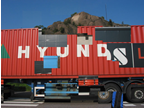
Algorithmic Montage 2: A Walk with David Bohm
Turbulence Spotlight: Algorithmic Montage 2: A Walk with David Bohm by David Crawford :: Needs Flash player.
"David Joseph Bohm (born December 20, 1917 in Wilkes-Barre, Pennsylvania, died October 27, 1992 in London) was an American-born quantum physicist, who made significant contributions in the fields of theoretical physics, philosophy and neuropsychology, and to the Manhattan Project." (Wikipedia) The audio in this video comes from an interview that F. David Peat conducted with David Bohm.
David Crawford studied film, video, and new media at the Massachusetts College of Art and received a BFA in 1997. In 2004, he received an MSc from Chalmers University of Technology. Crawford is currently a PhD candidate at the Faculty of Fine and Applied Arts at Göteborg University, Sweden.
Posted by jo at 10:40 AM | Comments (0)
February 06, 2007
F L U X L I N E S
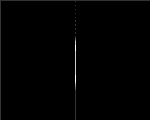
37 Short Fluxus Films
F L U X L I N E S, by Luca Lunk Leggero, is a personal rework of "37 Short Fluxus Films" in which 384x500 pixels videos become 550x1 pixels videos: LINE 01 ( Nam June Paik - Zen For Film )
LINE 02 ( Dick Higgins - Invocation of Canyons and Boulders )
LINE 03 ( George Maciunas - End After 9 )
LINE 04 ( Chieko Shiomi - Disappearing Music for Face )
LINE 05 ( John Cavanaugh - Blink )
LINE 06 ( James Riddle - 9 Minutes )
LINE 07 ( George Maciunas - 10 Feet )
LINE 08 ( George Maciunas - 1000 Frames )
LINE 09 ( Yoko Ono - Eye Blink )
LINE 10 ( George Brecht - Entrance to Exit )
LINE 11 ( Robert Watts - Trace #22 )
LINE 12 ( Robert Watts - Trace #23 )
LINE 13 ( Robert Watts - Trace #24 )
LINE 14 ( Yoko Ono - One )
LINE 15 ( Yoko Ono - Eye Blink )
LINE 16 ( Yoko Ono - Four )
LINE 17 ( Pieter Vanderbeck - Five O'Clock in the Morning )
LINE 18 ( Joe Jones - Smoking )
LINE 19 ( Erik Andersen - Opus 74 Version 2 )
LINE 20 ( George Maciunas - Artype )
LINE 22 ( Jeff Perkins - Shout )
LINE 23 ( Wolf Vostell - Sun in Your Head (Television Decollage) )
LINE 24 ( Albert Fine - Readymade )
LINE 25 ( George Landow - The Evil Faerie )
LINE 26 ( Paul Sharits - Sears Catalogue 1-3 )
LINE 27 ( Paul Sharits - Dots 1 & 2 )
LINE 28 ( Paul Sharits - Wirst Trick )
LINE 29 ( (unnumbered) Paul Sharits - Unrolling Event )
LINE 30 ( Albert Fine - Dance )
LINE 31 ( John Cale - Police Car )
LINE 36 ( Peter Kennedy & Mike Parr - Flux Film 36 )
LINE 37 ( Peter Kennedy & Mike Parr - Flux Film 37 )
LINE 38 ( Ben - Je ne vois rien, je n'entends rien, je ne dis rien )
LINE 39 ( Ben - Le Traversee du port de Nice a la nage )
LINE 40 ( Ben - Faire un effort )
[via Random]
Posted by jo at 08:33 AM | Comments (0)
January 24, 2007
RPM's Remixed
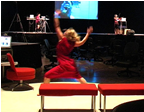
A Virtual Space "Sings"
RPM's Remixed is a telematic, transdisciplinary performance based on remixing Alvin Lucier's RPM's score – integrating dance, video and sound improvisation between artists in New York, Tampa, and San Jose.
Alvin Lucier, a well-known composer of music and sound installations that explore natural phenomena and resonance, is renowned for making spaces "sing." This piece explores the possibilities of using one of his scores to make a virtual space "sing" by using improvisational techniques as well as the natural feedback and delay created by streaming.
Themes exploring isolation, intersection, and madness reverberate through images, body and sound. Dancers and sound artists in San Jose, Tampa, and New York collaborate while realtime processing of the video images is driven partially by the performers’ movements. Motion analysis is sent over the network to trigger aspects of video manipulation, further blurring the lines of authorship and contributing to the impromptu chemistry.
Lucier’s original “RPM’s” score was a tongue-in-cheek take on creating sound based on depressing and releasing the accelerator of an Aston Martin engine. The score itself is a series of nonsensical curvatures and dashes – nonsensical, that is, until a personal interpretation of each written gesture is applied.
Taking this a step further, the cast of RPM’s Remixed deconstructs the score, into dance gestures, violin strokes, guitar riffs, and sound and video mashing. The challenge is not only to collaborate within one’s own medium but to improvise successfully between mediums and within a virtual space. Can the magic of improvisation reach across the ether? [via Rhizome]
Posted by jo at 09:33 AM | Comments (0)
January 19, 2007
The Way We Loop "Now:"
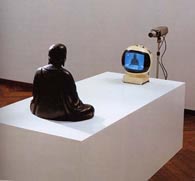
Eddying in the Flows of Media
"In 1974 Nam June Paik placed a statue of Buddha in front of a TV that displayed live feedback of the figure and titled it TV Buddha (fig. 1). The Buddha, an Eastern symbol of meditation and enlightenment, used in conjunction with the then-new technology of the closed-circuit loop, raises interesting questions about the relationship between subjectivity and media technology. Does the Buddha meditate upon itself or is it just another media effect, an eternal return of the simulated image of the self? Along with Paik’s other experiments with the new medium of video in the 1970s, TV Buddha reflected an early understanding of the control that media potentially had over the intellectual life of its viewers, while at the same time expressing Paik’s hope in its possibilities as an instrument of cultural exchange.1 The tension of TV Buddha resides in the precarious balance between meditation and mediation, between the consciousness and the constructedness of the self.
Approaching the relationship between subjectivity and media from a background in minimalism and performance, Bruce Nauman began exploring ways to actively involve the viewer. In Live-Taped Video Corridor, 1970, Nauman used closed-circuit video as part of a larger installation involving a too-narrow corridor to confound the participant’s spatial understanding. Mainly by attempting to alienate or otherwise aggressively engage museumgoers, Nauman has continued to explore the spectatorial role.2 With Think in 1993, (fig. 2) he created a piece in which a seemingly passive viewing state roughly akin to Paik’s Buddha is prodded into contemplation. Placing two monitors together, one upside down and on top of the other, each playing a looped video disc displaying his head moving into the screen, yelling “THINK,” Nauman took an even more aggressive stab at the way in which TV dictates, through direct address, the thoughts of the viewer.
The circulating systems of these two loops (Paik’s an indefinitely running live video feed, and Nauman’s a continuously repeating video disc), in which media generates the self and the self affirms media, pose the question of how we actually begin to approach thought or contemplation inside of the seemingly circular logic of media culture. Though made almost twenty years apart, both loops offer a common ground on which to address these questions. Their answer lies not in the alteration and subversion of the image, but in the duration and iteration of representation itself. Paik and Nauman were fascinated by the technical novelty of feedback and looping as well as their psychological and phenomenological effect on viewers. They both use the loop to mimic the temporal logic of repetition in the media, injecting humor and absurdity as a way to point to and potentially disrupt this condition from within." Continue reading The Way We Loop "Now:" Eddying in the Flows of Media by Jaimey Hamilton, Invisible Culture Issue 8.
Posted by jo at 06:39 PM | Comments (0)
January 15, 2007
37 Isolated Events
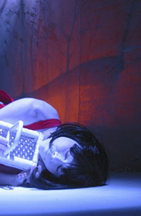
Contemporary Butoh Dance and Immersive Video Performance
37 Isolated Events: a Contemporary Butoh Dance and Immersive Video Performance :: Thursday January 18, 2007 - 7pm :: San Francisco Asian Art Museum :: free w/ $5-after 5 pm museum admission.
Blindsight Artistic Director/Choreographer Paige Starling Sorvillo collaborates with Los Angeles-based media artist Lucy H G and UK-based Australian composer duo imaginationandmymother.
this ocean is also the desert and I am walking into a minefield, into this installed landscape this land no longer part of the soul, I swallow, I listen, I can see your body cut into foreign lands.
37 Isolated Events begins with the normal running temperature of the human body and gradually fabricates a facsimile body. Within the noise of networked society, our intimate distance and distant intimacy induce a virtual, mediated sensibility. We are anesthetized - our breath mechanized - as the human biological system becomes hybridized with the global system. At thirty-seven degrees Celsius, in isolation, we have unprecedented potential to risk exposure and make contact inside the noise of a growing global network.
concept/direction | paige starling sorvillo
collaborating media artist | lucy hg (LA)
sound artists | imaginationandmymother (UK)
performance/choreography | sorvillo, monique goldwater, isabelle sjahsam, jez lee
lighting design | elaine buckholtz
photography | ian winters
San Francisco Asian Art Museum :: 200 Larkin, Samsung Hall (Civic Center BART)
37 Isolated Events is a supported in part by the Zellerbach Family Foundation and Asian American Dance Performances. Paige Starling Sorvillo is honored to be a 2007 CHIME awardee with Marc Bamuthi Joseph.
Posted by jo at 12:22 PM | Comments (0)
January 12, 2007
S Y N C H R O M Y
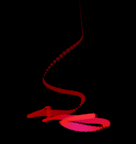
Spectator at the Heart of the Creative Processs
S Y N C H R O M Y by Olivier Ruellet :: January 9 - 23, 2007 :: Watermans Gallery :: the second work in the series "Sense Detectives" developed in collaboration with Thames Valley University.
Synchromy is an interactive video installation relying on motion tracking technology to place the spectator at the heart of a creative process: akin to a painting that would react to the level of motion expressed by spectators, Synchromy adapts its own visual dynamics to the rhythm shown by the audience, who develops in real-time a pictorial work of which they can start to understand the working and own it by becoming progressively more conscious of their gestures in front of the work, and thus explore new sorts of reaction between motion and image.
While at Watermans don't miss the chance to see the interactive installation M I R O R R O O M by Raylab at main gallery which is on display till 15 January. Mirror Room re-evaluates the visitor's image of himself/ herself and the relationship between technology, the body and space. Mirror Room was created back in 2002 and first featured at Extreme Computing exhibition that year and is collected here as a retrospective of Raylabs past playtimes.
Posted by jo at 05:11 PM | Comments (0)
December 08, 2006
Let's Puff

Pushing the Landscape
Let's Puff by Yang Zhenzhong :: Two Channel Video Installation [Movie]:
"After exploration in installation and photography, Yang Zhenzhong begins be engaged in large number of video experiments. His art style is mostly bright and intelligent, and his works usually make an individual inspection seemly ordinary and simple subjects to represent extraordinary connotation. Let's Puff, his video works for this Biennale reveals Yang Zhenzhong's easy and humorous character once more. In front of a fashionable girl, real city scenes become unreal game properties, then reality and unreality that are two seemly paradoxical realms convincingly overlap together in this specific time and space and successfully create a miraculous illusion."-- Li Xu/2002 Shanghai Biennale catalog
The work of Let's Puff is the video installation with two synchronized channels: In one of the two faced screens (video A), there is a girl who keeps on blowing; but in the another one, (video B), it shows the city scene becoming far and far away from us according to the rhythm of the blowing of the girl. During the production of the work, I had to solve several important technical problems.
"I chose the Nanjing road for the spot of video B. Nanjing road is the most famous commercial street with many remarkable buildings as symbols of Shanghai city. I called four friends to help me and borrowed a wheelchair on that day; just for ensuring the camera could be under smooth movement when I shot the video on the street. All the facilities and methods are simple but effective. One of the friends sitting in the wheelchair in responsible for holding the camera steady, I pulled the wheelchair to back up, running or pausing, with the walkman, by the rhythm of the sound from the CD. The other three friends behind me took the responsibility for dispelling the public in order to keep up the path without barriers. On such a sunny afternoon, we five weird guys, passed the Nanjing road streaming with sweat and, fortunately, we were finished within one hour,
After taking the shots, the main part of my work was editing the video. Actually, it was quite a lot of trouble to put the two videos into the same step.
In this work, I was also supposed to experiment with an interaction by using the illusion of image, which was how to transfer the view of city into a tool of the blowing game by a fashion girl. Of course, any imagination was welcome. This was accomplished by using the viewer and generating that from the effect of the work." [via]
Posted by jo at 08:35 AM | Comments (0)
October 27, 2006
Furtherfield Commissions 5+5=5
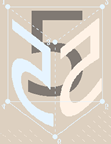
Exploring Imaginative and Critical Approaches to Social Engagement
5+5=5 :: 5 short movies by 5 film makers about 5 networked art projects :: Free Media - Mongrel + Polyfaith - Chris Dooks + Golden Shot (Revisited) - Simon Poulter + Want and Need - C6 + VisitorsStudio - Furtherfield.
5 short movies by 5 film makers about 5 networked art projects exploring imaginative and critical approaches to social engagement. Furtherfield has commissioned 5 short movies about 5 UK-produced networked art projects which explore critical approaches to social engagement.
These pieces offer alternative interfaces to the artworks and the every-day artistic practices of their producers. They introduce the motivations and social contexts of artists and artists' groups who are working with DIY approaches to digital technology and its culture, where medium and distribution channels merge.
These movies each feature the concepts, contexts and techniques involved in the creation of five specific pieces of work. They include conversations between artists, audiences/participants and film- makers, talking on their own terms.
Original concept and production Furtherfield, London, UK, 2006. In association with HTTP Gallery [House of Technologically Termed Praxis], London, UK. Made with the support of Stiftelsen Laangmanska Kulturfonden and Mejan Labs in Stockholm, Sweden - Arts Council of England and Awards for All in UK.
Posted by jo at 10:27 AM | Comments (0)
October 24, 2006
Paul Chan at

PORTIKUS
Paul Chan :: Opening: October 27, 2006, 8 p.m. :: Exhibition: Oct 28 – Dec 3, 2006 :: Press Talk: Oct 27, 2006, 11 a.m. :: PORTIKUS :: Alte Brücke 2 Maininsel, 60594 Frankfurt am Main, Germany :: Telephone +49 69 962 44 54-0 Fax +49 69 962 44 54-24.
The Portikus in Frankfurt am Main proudly presents Paul Chan’s first exhibition in Germany. Born in Hong Kong in 1973 and educated in the US, he has established himself as an important international artist. In the wake of 9/11 and the war in Iraq, Chan has become a key figure both in the American art world and in the world of political activism. He is also an artist who emphasizes what is specific of these two spheres.
Like fleeting shadows on the ground, we see objects defying gravity. Sunglasses, cars, people—everything is falling against a backdrop in shifting colours. But what appears to be simple shadows are digital animations projected on the floor—a recurring feature in Chan’s ongoing series The 7 Lights. Portikus presents 3rd Light, the first part to also involve a sculptural element: a 3-dimensional replica of the table in Leonardo da Vinci’s Last Supper. This ingredient emphasizes the theological quality already strongly felt in the previous chapters, and the first falling object to appear is an apple, followed by chairs and dogs. In spite of the calm and meditative atmosphere, this seems to be a work about a world falling apart. Here the world seems to end in silence.
Paul Chan creates films, animations and works with references to Goya as well as to Japanese pornography, to the Bible as well as to the Samuel Beckett. Previously this year he participated in the Whitney Biennial. Other recent exhibitions include a solo show at the ICA in Boston (2005), ‘Uncertain States of America,’ at Astrup Fearnley Museum of Modern Art in Oslo (2005), the Lyon Biennial (2005), and the ‘Greater New York’ at PS 1 in New York (2005).
This exhibition is accompanied by a catalogue produced together with Magasin 3 Stockholm Konsthall, where the artist currently presents other key works. Portikus’ and Magasin 3’s joint venture is the artist’s first institutional solo presentation in Europe.
Posted by jo at 02:01 PM | Comments (0)
October 20, 2006
Ah-ha: Narrative Structures in Reactive and Interactive Video Art

Connecting the Physical and the Digital
[Image left: "Guillotine" by Steve Shoffner) "Performance is so many things: the synchronized sounds of a symphony; actions with words in a play; steps and turns in a dance; words from a pulpit. Performance art, too, is variable, perhaps too multifarious to define, even with semicolons. At traditional performances with traditional support materials, from symphonies with program notes to theatre productions with playbills, performance acts as replay, a repeat of an event, a memorization of a string of notes or a set of lines, a reformulation of a tested formula. Then there are those performances that vary, that respond to the moment, that unfold through the implementation of chance or improvisation or, more and more, digitization. With the insertion of new technologies into performance, the question arises – do actions result from numbers? What indeed is the connection between the physical and the digital? Does the digital component determine the performance, or do actions generate a numeric pattern, which then underlies the piece's structure?
The aesthetic and conceptual import of digital performance pieces is linked to the ordering of a piece's technological components. Random sequencing is one form of structuring immersive environments or data-triggered scenes. Fixed sequencing of scenes, with a predetermined index of performed actions and triggered events, follows a preset score. Alternately, sensory responsive improvisation is flexible and often produces variations in structure. In each case, the piece's content is the result of a digital system: programming or computer responses to external stimuli determine how the performance plays out. Even interactive improvisation, in which a human action triggers a computerized event, is a digital system, albeit one that emphasizes the human element, or input, in that system. The content of an interactive piece is closely related to its structure – the interaction between trigger, whether generated by the viewer or performer, and event. Interesting variations in content emerge when the structure becomes the art.
Below, by electronic interview, four new media artists describe their modes of working with interactive technologies and probe the relationship between order and content in their work. Johannes Birringer makes telematic connections in performance, installation, and video. Mark Coniglio co-directs the interactive dance company, Troika Ranch, with Dawn Stoppiello; he both designed and implements the interactive software, Isadora. Cat Jones' alternate persona catgURL interacts with viewers while performing live on and off the screen. Steve Shoffner instigates interactions with viewers while performing simultaneously on video and within his installations." From Ah-ha: Narrative Structures in Reactive and Interactive Video Art by L. Hermes Griesbach, VJ Theory: ART, 12/10/06.
Posted by jo at 02:29 PM | Comments (0)
October 05, 2006
telly-stylee
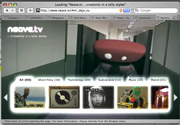
neave.tv
Artist Robert Neave presents neave.tv which pulls full screen, crisp video from blip.tv, google video and YouTube. You can view a random play or select from thematic interface.
Posted by michelle at 07:29 PM | Comments (0)
September 14, 2006
Jane McGonigal

Please feed (but don't fetishize) the participation
I'm feeling a bit squeamish about a lot of the lonelygirl discussion going on this week, in the wake of the previously secret puppet masters' curtain call. As someone who designs participatory experiences, often games with a serial narrative component, I think it's really important that we stop and look at the kind of participation and engagement actually engendered by projects that purport to solicit the collaboration of the audience.
In the LA Times, the producers of the You Tube serial drama describe their goals for engaging the audience:
The intent was to allow fan response posted in the comment section of lonelygirl15's YouTube and MySpace pages to determine the direction of each subsequent episode.As an example of the fans' influence over the story line, what the team calls "collaborative storytelling," they pointed to an episode in which Daniel reveals his romantic feelings to Bree. "In the 'Hiking' video," Beckett said, "where Daniel filmed her, there were a ton of comments saying, 'Daniel likes you. It's obvious that the cameraman was completely in love with you.' We saw the comments and said this is the perfect opportunity to address this."
Okay, fair enough. I'm all for collaborative storytelling. But I don't think it's right to accept this account of the kind of participation that happened during the lonelygirl project at face value. Today and yesterday I spent a lot of time reading through pretty much every single comment left on the lonelygirl videos, the space where the audience was purportedly invited to help decide and direct the course of the narrative. I would encourage anyone else interested in the currently much praised and hyped lonelygirl "community" to do the same. A great hub for doing this is here.
As the statistics on this traffic counter show, each lonelygirl video has roughly 1000-4000 comments, nearly all of them left before the puppet masters were unmasked. And I have to say this: the level of hate, mean-spiritendess, crudeness and often downright misogeny of the majority of them is impossible to ignore.
As we talk about the “new art form” or “participatory culture” aspects of this project, I want to be very careful that we don’t fetishize the participation aspects of this experience that was had by a very few who may have intelligently, passionately and seriously investigated and responded to the texts and the media objects. I want instead to think about the mainstream experience of and participation in this project and the success of the platform provided for engagement.
To give you an idea, here is a sample of comments that I would characterize as representative of at least 33% if not more of comments to the lonelygirl videos:
You are pretty boring. Get a psychologist.
Ok. Why don’t you just keep your personal problems to yourself and stop making a scene
show us your tits
you are really ugly i hope you know that
Your eyebrows are too far apart. But, you’re still pretty.
Fuck you. Welcome to the new world we Don’t Have to Respect what you think. get over it
I hope Daniel rapes you. No hard feelings.
WHORE lol
HHHmmmmm,your caucasian,live in a decent to luxurious house, are well taken care of,and it looks like you are one of those spoiled girls that kiss ass to thier daddy.Think you have it rough?Why dont you come live in East Los Angeles,whee you cant go anywhere without being shot at,you fuckin spoiled brat.
Cry me a river bitch, your a teenager, do what your parents say bitch.
(Most discussion in the comments is not about whether lonelygirl is real or not-- they appear to accept the videos at face value, or otherwise not to care whether they are insulting a "real" girl or an actress.)
So: Is this really the birth of a new art form? Is this a kind of social participation that we like or find interesting? I'm all for participatory entertainment. But let's carefully design platforms, vehicles, and contexts for participation that really work to engage audiences, players, makers, collaborators in meaningful ways.
One more point I want to make: I think this question of "is she real or not" and how does the audience feel about being hoaxed or played with is a really important one. Although many, many viewers were openly skeptical or cynical about the verity of lonelygirl's professed identity, from what I can tell, far more took it close enough to real to play along.
Now I've written a lot about, and worked on quite a few, projects that ask players to perform belief in the story and game experiences, but--and here's the key distinction--without presenting actually credible fictons. (Stories set 500 years in the future, for instance, or involving poker rooms full of ghosts). The media itself never clearly said "I'm not real", but the content absolutely had no chance of fooling anyone. So I'll come out and say it: I don't personally like entertainment in the form of credible hoaxes. Not necessarily from a moral position, but rather because I believe that "real or not" distracts from the more important question: How can I meaningfully engage?
I agree that serial drama on You Tube is a great art form (so are traditional ARGs, the more elaborate art form that lonelygirl represents a pared back style of, in my opinion), but the real conversation should be not about the realness, but rather: How do people want to participate in it? Do they want to be the makers of their own videos? To have role-playing style conversations in the comments? Do they want to directly influence the narrative or to just speculate and gossip about it so they can be proven right by what happens next? And most importantly how do we inspire participation that is more than hostile juvenile comments? How do we create a real participatory community around an entertainment property, and what forms of participation are possible... and desirable? [posted by Jane on Avant Game] [Related post]
Posted by jo at 06:18 PM | Comments (0)
September 12, 2006
lonelygirl15

"we are witnessing the birth of a new art form."
Over the last week, i've gotten innumerable emails about lonelygirl15. Folks were wondering if i was behind it or if i knew who was. They wanted to know my opinion, if i thought it was fake.
I did. I thought it was fake but i expected that it was a TV or movie organization. I was kinda curious if it was an ARG but it didn't look like it. I decided that i should do a proper analysis of the different bits when the news broke: LonelyGirl15 is crafted by a group of filmmakers as an art project. Here's the letter they wrote to their fans on the forum explaining LonelyGirl15:
To Our Incredible Fans,
Thank you so much for enjoying our show so far. We are amazed by the overwhelmingly positive response to our videos; it has exceeded our wildest expectations. With your help we believe we are witnessing the birth of a new art form. Our intention from the outset has been to tell a story-- A story that could only be told using the medium of video blogs and the distribution power of the internet. A story that is interactive and constantly evolving with the audience.
Right now, the biggest mystery of Lonelygirl15 is "who is she?" We think this is an oversimplification. Lonelygirl15 is a reflection of everyone. She is no more real or fictitious than the portions of our personalities that we choose to show (or hide) when we interact with the people around us. Regardless, there are deeper mysteries buried within the plot, dialogue, and background of the Lonelygirl15 videos, and many of our tireless and dedicated fans have unearthed some of these. There are many more to come.
To enhance the community experience of Lonelygirl15, which you have already helped to create, we are in the process of building a website centered around video and interactivity. This website will allow everyone to enjoy the full potential of this new medium. Unfortunately, we aren't programmers. We are filmmakers. We are working furiously to complete the website, and hope to have it up and running shortly.
So, sit tight. You are the only reason for our success, and we appreciate your devotion. We want you to know that we aren't a big corporation. We are just like you. A few people who love good stories. We hope that you will join us in the continuing story of Lonelygirl15, and help us usher in an era of interactive storytelling where the line between "fan" and "star" has been removed, and dedicated fans like yourselves are paid for their efforts. This is an incredible time for the creator inside all of us.
Some thoughts
Now that i've killed the suspense, let me back up and tell you about what happened. For those who aren't familiar, videos by LonelyGirl15 started appearing on YouTube over the summer. She's supposedly a teenager who is homeschooled by religious parents who don't know she's creating videos online. Her friend Daniel helps her with the videos and they often talk back and forth across their videos. It's rather endearing but too good to be true.
As more videos popped up, people started questioning whether this was real or not. Speculation mounted and fake lonelygurls started to appear. People created videos to comment on LonelyGirl15. People flocked to the LonelyGirl15 forum to discuss. Problem is the LonelyGirl15 domain was registered before the videos started appearing. People started tracking down more and more clues, trying to hone in on what it was, who was behind it. Suspicion mounted. In classic fan style, people dove right down and tore apart all of the data. Quite a few thought that this was an ARG, Jane McGonigal style, but she denied involvement on NPR. Others thought it was an advert or some marketing campaign.
The clues people dug up were fascinating. Personally, i was intrigued by "Bree's" MySpace profile. I knew it was fake but i didn't know if the YouTube LonelyGirl15 made the MySpace profile LonelyGurl15. Why did i know it was fake? Well, i read too many teenage MySpaces. Not sure i should give away clues as to how to create a real-looking fake MySpace profile. ::wink::
Then press started covering it. Hands down, The New York Times had the best coverage. I can't help but wonder if the NYTimes knew the truth because they are certainly using the same language: "Hey There, Lonelygirl - One cute teen's online diary is probably a hoax. It's also the birth of a new art form." If so, go Adam for good reporting!
I like the idea that it is an art form but i also think it's part of what Henry Jenkins calls Convergence Culture. Regardless, it's super cool that people are using new media to create narratives. They are telling their story, truth or fiction. Of course, this makes many people very uncomfortable. They want blogs and YouTube and MySpace to be Real with a capital R. Or they want it to be complete play. Yet, what's happening is both and neither. People are certainly playing but even those who are creating "reality" are still engaged in an act of performance. They are writing themselves into being for others to interpret and the digital bodies that emerge often confound those who are doing the interpretation. In many ways, this reminds me of the Fakester drama during the height of Friendster. As one of the instigators behind the Fakester manifesto explained, "none of this is real." I won't get all existential on you so we'll leave it at that.
In many ways, i have to admit that i'm sad that the truth is out. I was really enjoying the suspicion. Far more than any episode of Lost or reality TV show. I was enjoying not knowing who was behind it and spending hours speculating and trying to find hints. I was enjoying watching a community of people talk endlessly about what they thought might be going on. Sure, the videos were quite endearing (although the ending of Poor Pluto disturbed the hell out of me) but do i just want to watch the videos by themselves? I'm not sure. I think i liked them for the mystery.
Regardless, i absolutely love the way people are using all of these new social technologies to create cultural experiments. To me, this signifies the importance of social media.
Update: The LATimes is reporting that emails concerning the site come from the Creative Artists Agency (CAA), a talent agency in Beverly Hills. (Perhaps i wasn't as off as i thought?) [blogged by zephoria on apophenia]
Posted by jo at 03:22 PM | Comments (0)
August 28, 2006
Playback_Simulated Realities

The Impact of Re-Enactments on Society
Playback_Simulated Realities :: 3 September - 5 November 2006 :: Opening: 2 September 2006, 7 p.m. :: Participating Artists: Ant Farm and T.R. Uthco, Christoph Draeger, Omer Fast, Beate Geissler/Oliver Sann, Lynn Hershman, Felix Stephan Huber, Eddo Stern, Milica Tomic, Susanne Weirich.
Public interest in elaborately staged history spectaculars which are supposed to bring the past to life as realistically as possible by virtue of faithful adherence to detail continues to grow apace. The form used for re-enacting political events and milestones of world history is also increasingly shaping approaches to art. Forms of 're-enactment' and simulation occur above all in the context of the new technologies. The exhibition "Playback" investigates the influence and impact re-enactments and simulations have on society. It raises questions about the function of the digital substitute worlds developed in computer games in satisfying viewers' needs. It discusses the yearnings for authentic experience which are also addressed in reconstructions of past eras. In a 'society of spectacle', which only values reproduction, it raises the question of whether we can still trust our own experiences and memories and, if so, to what extent.
What changes take place when historic events are retold? The works shown in the exhibition examine in reconstructions and stagings how experiences and memories are at once individually experienced and culturally construed.
The Eternal Frame, a video by the Ant Farm and T.R. Uthco group, is a critical commentary on the globally reknown images of the assassination of John F. Kennedy disseminated by the mass media that has engraved themselves on our collective memory. Christoph Draeger's Black September restages the terrorist attack that claimed eleven victims at the 1972 Munich Olympic Games; fact and fiction, past and present are so intricately interwoven that the boundaries between documentary and real experience are blurred. In his video Spielberg's List, Omer Fast deals with the construction of, and response to, the past, describing the casting process and what the cast of the Holocaust film "Schindler's List" by Stephen Spielberg experienced in making the film.
Return to Veste Rosenberg by Beate Geissler and Oliver Sann plunges viewers into a computer game that has become reality. Pictures of soldiery deployed in a medieval fortress alternate with fairy-tale shots of enigmatically phantasmagoric figures from a different time. In her documentary feature film Strange Culture, Lynn Hershman relates the dramatic events which changed the life of artist Steve Kurtz when the FBI, after the tragic death of his wife, suspected his art activities as an act of eco-terrorism. In the video Vietnam Romance, Eddo Stern investigates the influence of mass-media images on public perceptions of wars and shows images from computer games that recreate the representation of the Vietnam War in Hollywood films. In the computer installation Ops Room by Felix Stephan Huber, the player is caught up in the simulation of an historic place. What is staged is the celebrated control room realised in Santiago de Chile by the cyberneticists Stafford Beer and Fernando Flores in 1972, which was intended to be used as an instrument for computer-controlling the interventionist socialist economy under Salvador Allende.
In Container, Milica Tomic has succeeded in creating a memorable link between questions of identity and memory, personal and political history. Dependencies and power politics experienced by members of a capitalist society are subjected to radical criticism in this video and slide show, in which she refers to the issue of human beings as wares. In Silent Playground, Susanne Weirich stages six film sequences, which borrow the logic and setting of computer games. Matching the binary strategy of such games, each filmic sequence has a good and a bad ending.
Events: Friday, 8 September, 8 p.m. :: Sir Drone (1989) by Raymond Pettibon :: Filmscreening within the scope of the Oldenburger Filmfestival
A catalogue will be published.
Guided Tours: every Sunday, 3 p.m.
17 September and 22 October: guided tour by Sabine Himmelsbach
Edith-Ruß-Haus für Medienkunst
Katharinenstraße 23, 26121 Oldenburg
t. +49 (0) 441 - 235 3194, http://www.edith-russ-haus.de
Posted by jo at 03:24 PM | Comments (0)
August 23, 2006
Seven Maps
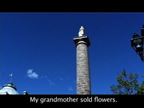
Call and Response
When filmmake /videoblogger Daniel Liss challenged himself to make 7 videos in 7 days, he also challenged his online audience to collaborate with him in the process. His daily assignments came from viewers of his videoblog who determined where, about what and how he should make each video.
Each day, they posted an assignment and each day Daniel posted a video in response. Then came praise and criticism in the comments of each day's videoblog post. The process took him miles from home, he told personal stories, invented new narratives, and played more than a few tricks on his guiding/goading audience.
For this video he was given the assignment, 'oday, you are a local. Trick us into believing that you are a local. Tell us a story about your history.' The entire Seven Maps series can be seen here : http://pouringdown.tv/sevenmaps [blogged by mica scalin on DVblog]
Posted by jo at 08:47 AM | Comments (0)
August 18, 2006
MPG: Mobile Performance Group
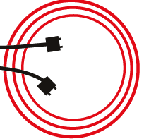
Art to Go
Founded by Matt Roberts, the MPG: Mobile Performance Group is a collective of new media artists interested in finding new ways to present art outside of traditional venues. MPG disseminates their work by using automobiles, video projection, cell phones, FM transmission, wireless hotspots, and any other technologies that allow artist to engage the public.
Parking Spaces investigates one of the most ubiquitous spaces in the United States, the parking lot. MPG moves through the city looking for empty parking lots to collect sounds and images. Using the collected material MPG creates an improvised performance in the space. Images from ZeroOne ISEA2006. Multi media feature from Mercury News. Flickr.
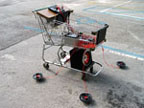
Shopping Carts: Using recycled cardboard, solar power, batteries and multimedia equipment, MPG converts shopping carts into modular performance units. During the day the carts are used to collect energy, sounds and images. Each cart is equipped with solar panels and batteries for energy collection. They are also equipped with audio/video recording equipment for sound and image collection. During the night carts carry panels, made of recycled cardboard, that allow several carts to connect and provide table space for the performers. The three basic carts are audio, video, and power. The audio module carries speakers, amps and mixing board. The video module carries video projectors, cameras, and lcd screens. The power module carries batteries, inverters and power strips to provide power for the performers.

Inflatables: A series of inflatables that can be used as performance space and projection screens. MPG is working with designer Gerry Christensen and a group of his students to create a series of apparatus for mobile performance. These apparatus include a bike trailer with a hybrid power source and wearables for performance space. The bicycle trailer is equipped with solar panels for energy collection and storage, and has the ability to tap into public power outlets. The trailers can cary multimedia equipment, local wireless network, and provide portable power. The wearable are portable devices that performers can wear to carry equipment and also convert into seating/table space for performance.
More information here. [thanks Craig]
Posted by jo at 10:29 AM | Comments (0)
August 17, 2006
LOCUS SONUS
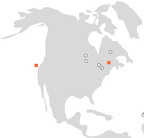
DUPLEX PERFORMANCE
THE THING invites your face and body and voice to 11 Harrison Street, ground floor storefront gallery, RIVERFAWN, for the Manhattan interface of THE THING.residency: LOCUS SONUS DUPLEX PERFORMANCE. This is a special performance that will be live from the Roebling Bridge on the Delaware River and from the RIVERFAWN Gallery in New York City. You will be part of the performance! :: 6pm –10pm Thursday August 24th :: 11 Harrison Street, ground floor* :: New York City.
Locus Sonus has constructed for this performance 2 IP webcams/parabolic microphones with which they can hunt for sounds in and around the venue streaming them simultaneously to the remote location. In each location laptop performers capture and remix the audio from the mic and video projectors show what the mobile microphones are capturing. Both mixes are played in both locations, the musicians responding to their remote counterparts. The Roebling Bridge will be set up on both sides of the river (the audience will be on the bridge). The idea being that we can use the local distance to reflect the remote distance. On the Manhattan side, the performance will take place in the RIVERFAWN Gallery where they will also use the wire/stream interface as an instrument to mix and control during the presentation. Live sounds from around the world (from the locusonus open web mics project) will also be used as raw material for the concerts.
Locus Sonus will be in residence between the 15th and the 29th of August in the USA with two installations and a duplex performance between them. The two locations will be at the DIGIT Festival, Delaware Valley Arts Alliance & Roebling Bridge Environmental Arts and at the RIVERFAWN Gallery in New York City.
DATES: The Installation at the Delaware Valley Arts Alliance opens on Saturday, August 19th and runs until August 25th. The performance Duplex Roebling Bridge/Manhattan will take place Thursday, August 24th at RIVERFAWN Gallery, 11 Harrison Street in New York City. There will also be a physical installation/interface on view from August 22nd to the 27th, 12-6pm at RIVERFAWN Gallery.
For more information: http://nujus.net/~locusonus/site/index_e.html
Audio streams: http://nujus.net/~locusonus/site/documentation/allstreams/index_e.html
ABOUT LOCUS SONUS
Locus Sonus is a research group specialized in audio art (École Supérieure d'Art d'Aix-en-Provence, École Nationale Supérieure d'Art de Nice Villa Arson). Our objective is to experiment and evaluate the innovative and transdisciplinary nature of audio art forms in a lab-type context. We are are also concerned with the communal, collective or multi-user aspects inherent to many emerging audio practices and which necessitate working as a group. Two main thematics define this research - audio in it's relation to space and networked audio systems. The "Lab" proposes a process combining practical artistic experimentation and critical evaluation in a group context. The Locus Sonus Lab is currently focusing on a process which revolves around the use of multiple audio streams. The streams which are basically open-mic continually upload chosen soundscapes or sound environments, as playable material. The way in which we work with other people to set up and maintain the streams is part of the methodology, indeed the technology provides the basis to construct a human network.
*Directions: by subway take 1 train to Franklin Street. Walk one block west on Franklin to Hudson and cross the street. Walk 1 block south to Harrison and turn right. 11 Harrison street is in the middle of the block on the south side of the street, By car: From uptown Take West Street to Vestry. Make a left on Vestry. Go two blocks make a right on Greenwich Street. Go two traffic lights , make a left on Harrison street. From downtown take West Street to Harrison street. Make a right on Harrison and go 1 block.
Posted by jo at 09:25 AM | Comments (0)
July 12, 2006
Guerrilla Net Ballet Performance: Ballettikka Internettikka:
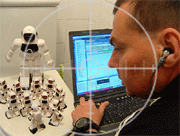
VolksNetBallet
Guerrilla Net Ballet Performance: Ballettikka Internettikka: VolksNetBallet by Igor Stromajer & Brane Zorman :: People's Internet Ballet furtively performed at -- and secretly broadcasted (as six one-minute live streaming videos) from -- the Basement Toilet in Volksbühne at Rosa-Luxemburg Square in Berlin, Germany; # Latitude: 52.31.36.84 N, Longitude: 13.24.43.02 E, Terrain Elevation: 41 m on Sunday, July 9th 2006 at 9 PM GMT+1 (Berlin/Paris local time). "Stromajer and Zorman manipulated a semi-automatic flying cow and eleven robots dancing an internet ballet, MC Brane conducted an MP3 orchestra!"
VolksNetBallet was broadcast in the form of six one-minute streaming videos, almost live, with only two minutes delay. It means that the visitors could see and hear in six steps what had just happened only two minutes earlier during the VolksNetBallet in Volksbühne Basement Toilet. All six videos were edited live in-camera, using only STOP and REC functions, then immediately converted to Real Media files using Real Producer, and finally, transferred to the server for viewing.
Ballettikka Internettikka is an ongoing artistic study of the internet guerrilla performance. After invading The Bolsh.oi Theatre in Moscow (March 2002), La S.cala in Milan (November 2004) and The National Theatre in Belgrade (October 2005), Stromajer and Zorman performed a new guerrilla net ballet, this time in the men's toilet in the basement of Volksbühne Berlin. The artists utilized low-tech mobile and wireless equipment for the invasion and live broadcast: a public unprotected wireless internet connection point (wLAN), available for free at the Rosa-Luxemburg Square in Berlin (ID: Helmut22; signal strength in the basement of Volksbühne: 2/5), free RealProducer (version 11.0) and Live LE software for streaming video and audio live manipulation. Ballettikka Internettikka: VolksNetBallet took place on the very same evening and at the very same time as another huge people's festivity -- the final match of the World Soccer Cup 2006, which also took place in Germany.
Dancing a wireless people's internet ballet in Volksbühne Berlin represented a big conceptual and strategic challenge to the Intima Virtual Base and all the collaborators, therefore, the preparations were taken seriously, safety measures were calculated, and the previous experiences from the Bolsh.oi Theatre in Moscow, La S.cala in Milan and The National Theatre in Belgrade were very welcome.
Note: Volksbühne Berlin did not voluntarily co-operate in the project, but was selected based on the conceptual strategy of the project. The management of the Volksbühne Berlin was not a co-producer of this project and did not co-operate in the process of its realization.
Posted by jo at 06:13 PM | Comments (0)
July 10, 2006
Chasing Pools and Sampling Ghats

HIDRAZONE ISSUE 002 X 2
Chasing the Pools is an immersive performance/installation working with integra-ting the live presence of dancers into the landscape of a multi-channel live-mix video installation. Often the two present very different viewing circumstances that remain independent of one another.
Through live-feed cameras the movement of dancers was mixed into the alpha channel of 3 video mixes. Their lit bodies became one moving image, dematerializing or re-materializing the body, while the background remained another. The dancers were able to monitor how they were affecting the composited image, essentially dancing with the image.
These channels were projected onto numerous scrims in a large tree grove. Twelve channels of sound by live musicians were mixed and spatialized throughout the site. The architecture of a tree grove naturally imposed a de-centralized structure upon the viewer where one’s experience was shaped by the act of meandering through, never being allowed a view of the whole.

Samples of the Ghats is a responsive installation that invites the audience to explore the ghats of Haridwar, India by composing themselves its audio-visual atmosphere.
A 5 metre long structure featuring a panorama of the ancient and holy city of Haridwar framed with technology is a stimulus to curiosity, an appeal to exploration. Cruising along the panel visitors soon discover that they can "play it." With the simple move of his hands he launches media sequences. They are audio and visual samples, pieces of Haridwar, collected and edited in a way to generate an atmospheric feel of the ghats.
In a collective experience, the panorama comes to life and the adventure begins.
More Hidrazone Issue 002: Performativity
Posted by jo at 07:26 PM | Comments (0)
June 28, 2006
Worldbench

Uniting School Children Around the World
Worldbench, by Greyworld, is an ambitious art installation that uses park benches to unite locations around the world from Berlin to Newcastle, London to Cape Town.
Each installation is situated in a school and consists of a bench placed next to a wall onto which is projected the mirror image of the bench. However, whilst one side of the bench may be in the grey playground of a primary school in Newcastle the other is in the sun-baked play - ground of a school in Cape Town. The people sitting on the bench can have an idle conversation, discussing their lunch or perhaps indulging in a little light flirtation, which they would have were they sitting on the same bench and not separated by thousands of miles.
Several benches have been installed in five schools across the UK, one in a dynamic inter-racial primary school in Cape Town and another in a secondary school in Berlin.
Posted by jo at 07:09 PM | Comments (0)
June 15, 2006
Cinema-Scope Hamptons

Last Minute Call for Video and New Media
Cinema-Scope Hamptons: Deadline: Monday July 3, 2006 -- (FUTURE PERFECT) The future perfect is used to describe an event that has not yet happened but is expected or planned to happen.
"Think of it. We are blessed with technology that would be indescribable to our forefathers. We have the wherewithal, the know-it-all to feed everybody, clothe everybody, and give every human on Earth a chance. We know now what we could never have known before -- that we now have the option for all humanity to make it successfully on this planet in this lifetime. Whether it is to be Utopia or Oblivion will be a touch-and-go relay race right up to the final moment." BUCKMINSTER FULLER, Critical Path
This year in the Hamptons we will have an impressive video art complex featuring some really top notch international artists striving to be ahead of the curve. We will also be featuring the new and improved "Perpetual Art Machine" interactive video installation. (sign up its free)
We are looking for additional screen based videos (HD and SD) no longer than 10 minutes and computer based new media projects, websites, vblogs and anything else that you would consider to be art on a computer.
All projects must have been created after 2001.
Video Requirements: Quicktime (.mov) or NTSC video DVD
New Media Requirement: Internet URL or Stand alone MAC formatted applications (Special thanks to Tekserve NYC for sponsoring us with the Cinema-scope MAC New Media Gallery)
Deadline: All work must arrive by Monday July 3, 2006. Late entries will not be accepted
Please send your entry to:
Lee Wells / Cinema-scope
Scope Art Fair
521 West 26th Street
New York, NY 10001
Please have disk and materials properly marked with artist name and artwork information.
Please include a self addressed stamped envelope if you would like your entry returned.
Please contact Lee Wells for further details by email lee[at]leewells.org or by phone at 917 723 2524.
Posted by jo at 02:58 PM | Comments (0)
June 08, 2006
V1B3: Video in the Built Environment
![]()
Call for Participation
V1B3 is requesting submissions of short videos* that in the broadest terms possible, explore public space though human interaction, intervention and the mechanisms that influence and control the experience of the city.
V1B3 is an international curatorial project that aims to present video art that responds to the conditions of site specificity and a public viewer-ship. Urban planners and architects are used to shaping cities by means of infrastructure, zoning and buildings. However, other modes of intervention exist that are capable of influencing the development of a city. Communicative media interventions can transform public spaces.
V1B3 Summer06 will be presented in conjunction with the University Film and Video Association conference, sponsored by Chapman University in Orange, California. The US screening will occur during the UFVA conference [August 1ST-5th] in Orange, CA. The UK screening will be held at the London Study Center.
V1B3 Summer06 will have a companion DVD developed for publication and purchase.
July 7th DEADLINE: Application can be found at http://www.v1b3.com
US Contact:
Mat Rappaport
1511 North Astor St
Milwaukee, WI USA
info[at]v1b3.com
Sceenings Will be August 1st – 5th
* up to 2 minutes in duration. Works longer than 3 minutes will not be considered.
Posted by jo at 09:12 AM | Comments (0)
June 05, 2006
Shilpa Gupta
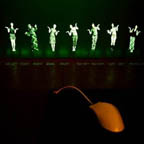
The Dwindling Power of Individual Reason
Bose Pacia presents recent work by Shilpa Gupta from May 17th through June 24th. Shilpa Gupta creates artwork using interactive websites, video, gallery environments and public performances to probe and examine subversively such themes as consumer culture, exploitation of labor, militarism and human rights abuse. In her debut solo exhibition in New York, Gupta presents an interactive video installation as well as other multimedia works and photography.
Her Untitled, 2004-2005 (interactive video) is an interactive new media installation in which the viewer is invited to manipulate a large wall projection. The projection features several figures in fashionable camouflage clothing engaged in various poses. The absurdity of their gestures and costumes recall both the mimicry games of childhood and the unforgiving rigor and conformity of military drills. In enabling the viewer as a participant, the work comments upon the dwindling power of individual reason in the face of 'mindless violence' borne out of fundamentalism and imperialism.
Her Untitled, 2005-2006 (touch screens) initially appears benign in content. One screen presents a bucolic landscape, another, the laughing faces of children, a third, a misty window. As the viewer touches each screen to initiate activity, darker truths emerge. The lush countryside of Kashmir is dotted with military guards and the smiling children are innocently posing alongside the remains of a bomb blast. From the misty window, a finger follows that of the viewer to spell out a militaristic alphabet: A for army, B for bomb, C for curfew. Gupta guides her audience to reveal the fear and uncertainty that pervade everyday life in this contested terrain and more broadly, demonstrates how truth is a fragile construction utterly dependant on the direction and intensity of one?s gaze.
Shilpa Gupta was born in Mumbai, India in 1976 and studied sculpture at the Sir J. J. School of Art there. She has exhibited widely and recent shows include the Havana Biennial (2006), ICC Tokyo (2005), Edge of Desire (New York, 2005) and Century City at the Tate Modern (2001, London). She was also commissioned to create Blessed Bandwidth.net, a net art project for Tate Online. In 2005 she was a runner-up for the Leonardo Global Crossings Award, Leonardo Magazine, MIT Press and in 2004, she was awarded the prestigious Transmediale Award in Berlin. Upcoming projects include the 2006 Sydney Biennial, the 2006 Liverpool Biennial and a two-person exhibition at Daimler Chrysler Contemporary in Berlin. Gupta currently lives and works in Mumbai.
Bose Pacia is located at 508 West 26th Street on the 11th Floor, in the Chelsea district of New York City. Gallery hours are Tuesday through Saturday from 12 to 6 pm and by appointment.
Posted by jo at 11:39 AM | Comments (0)
June 01, 2006
ELIZABETH LEISTER
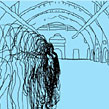
EVERY BODY IS EVERYWHERE AND NOWHERE
Every Body is Everywhere and Nowhere combines performance and technology in an immersive video installation. This new project continues Elizabeth Leister's themes of transformation and control in relation to the body. Leister's performative investigation is informed by a history of body-based performance art, including, Ana Mendieta's "Silhueta Series", "Push Ups", by Vito Acconci and "Up To and Including Her Limits" by Carolee Schneemann. Like the aforementioned, Leister uses video images of body imprints and line drawings, actual and animated, to study the physical and virtual body in space.
What occurs when the body is transformed through our use of technology? The amalgamation of video, performance and drawing in Leister's project links the traditional to the technological and emphasizes the physical impact of our bodies on the world we live in with one another. Our body language, sense of touch, corporeal presence and physical movement through space become invisible as we interact via machines. What is lost? What is gained?
Leister will perform a drawing to define her own physical borders within a specific moment in time and space. This drawing will be made each day for the duration of the exhibit in Leister's Los Angeles studio and transmitted through live-feed via web-cam, into The Morris Gallery in Philadelphia. The traditionally intimate space of performance will expand as the body of the artist is projected across space and time. Made up of shifting light and pixels traveling through cyberspace, the body becomes expansive and limitless.
A second video shows a collage of the imprints left behind by Leister's family and friends: a snow angel, footprints in the sand, a sweater tossed to the ground. A third projection of an animated drawing outlines, frame by frame, a body moving through space. Like the drawing created in the performance, lines are built up to define a path of movement, then reverse and erase.
A computerized voice expresses a desire to be everywhere and nowhere, everyone and no one while a second audio track, taken from Leister's writings, is an overlay of a human voice whispering as if she were light and breath in an unnamed space.
Finally, the video projections will be installed in relation to a set of mirrors to create a kaleidoscope of images that will reflect the body of the viewer. Through live-feed performance, drawing and video the project will juxtapose the physical body and the immateriality of the virtual body.
The exhibition in the Morris Gallery at the Pennsylvania Academy of Fine Arts opens on June 10th and runs through August 20th. The installation, which will open with a free reception June 9 from 6 to 8 p.m., is curated by Alex Baker, the Academy's Curator of Contemporary Art.
Museum hours are Tuesday through Saturday, 10 a.m. to 5 p.m., and Sunday, 11 a.m. to 5 p.m. The Academy is located at 118-128 N. Broad Street in Philadelphia, two blocks north of City Hall. Regular admission is $7 adults, $6 seniors and students with ID, $5 children / youth ages 5-18, free for members and children under age 5.
Elizabeth Leister received an M.F.A. in sculpture from the Milton Avery Graduate School of the Arts at Bard College and a B.F.A. from the Tyler School of Art. In Philadelphia, her work has been exhibited at the Philadelphia Museum of Art and Nexus Foundation for Today's Art. Her work has also been shown at the Delaware Museum of Art, the North Dakota Museum of Art, Art in General and P.S. 122 in New York, and the Kellogg Art Gallery at California State Polytechnic University, Pomona, among others. She has received awards from the Pennsylvania Council on the Arts and the Leeway Foundation.
Posted by jo at 11:06 AM | Comments (0)
May 18, 2006
Alan Sondheim with Leslie Thornton
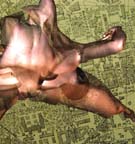
em/bedded
Track 16 Gallery presents em/bedded: A multi-media installation by Alan Sondheim with Leslie Thornton; Guest curated by Tyler Stallings; May 27-June 24, 2006; Reception: Saturday, May 27, 6:00-9:00 p.m.; Performance: 8:00 p.m. Free.
About the performance at 8:00 p.m.: Alan Sondheim will present em/bedded (assembled performance) (45 mins. approximately). It consists of a laptop performance that deals with political, sexual, and cyber issues. He runs video/audio/text segments from a laptop in combinatory fashion, typing a real-time commentary at screen bottom. The result is an extended body, the digital problematized by analog, purity by error, language by language-stumbling. He uses various avatars who “live” in a world that has collapsed into pixel- annihilation.
About the installation: In his first solo exhibition in California, Alan Sondheim, along with filmmaker Leslie Thornton, will transform Track 16 Gallery’s cavernous main gallery into the multi-media installation, em/bedded. Sondheim brings together video projections of cyborgian, mutating, sexual bodies and the artifacts of battlefields soaked in banal horror. Together, they offer a distorted beauty of the disasters of war and the pleasures of love. Guest curated by Tyler Stallings.
Scattered amongst the video projections of furiously moving dancers, of sexual confrontations, of computer generated “avatars,” there will be antennae, battlefield telephones, off-kilter combat tents, photographs of battleships, trenches, and bodies, souvenirs taken from Japanese soldiers, old microscope slides, and antique book editions of du Maurier's Trilby, Confessions of a Magnetiseur, a Japanese pre-Meiji book of black and white block prints of Westerners, Volney's Ruins of Empire, and Albert Dreyfuss' Five Years of My Life. Together they all suggest attempts at communication amidst fortifications created around language and confinement.
Integral to the installation will be a large tent that contains Leslie Thornton’s recent video work, Let Me Count the Ways: Minus 10, Minus 9, Minus 8, Minus 7, Minus 6…. In this work, Thornton explores the social effects of new technologies and media, but here she pushes even further into autobiographical territory to suggest the ways in which we are all implicated in these changes. Juxtaposing aerial footage of pre-9/11 New York City; scientific data on genetic mutation; audio testimony about the bombing of Hiroshima, and a home movie of her father, an engineer on the Manhattan Project, as he is dispatched to that city, Thornton creates a dense and compelling meditation on violence.
Like nomads, Sondheim and Thornton create an ensemble of videos and the physical remains of history that traverse the landscape of memory and time. The work occurs in the far future - mutations, extinctions, broken spaces of information. The work occurs in the past - organisms huddled as if protected against the fury of the world, primitive electrical machines tuned into atmosphere and universe. In em/bedded, the distorted bodies are our own of course, in the present, of course. em/bedded offers no solution - there isn't any - but presents a distorted beauty of its own within an image storm that is a continuous splay, spew, emission, of violence, sexuality, and cloned
grotesques.
Track 16 Gallery
Bergamot Station
2525 Michigan Ave., C1
Santa Monica, CA 90404
310.264.4678
About the artists and the curator
Alan Sondheim's work is trans-media; his emphasis is on writing, theory, and digital performance.
His books include the anthology Being on Line: Net Subjectivity (Lusitania, 1996), Disorders of the Real (Station Hill, 1988), echo (alt-X digital arts, 2001), Vel (Blazevox 2004-5), Sophia (Writers Forum, 2004), Orders of the Real (Writers Forum, 2005), and The Wayward (Salt, 2004) as well as numerous other chapbooks, ebooks, and articles. His video and film have been widely exhibited. Sondheim co-moderates several pioneering email lists, including Cybermind, Cyberculture and Wryting. Since 1994, he has been working on an Internet Text, a continuous meditation on philosophy, psychology, language, body, and virtuality. In 1999, Sondheim was the 2nd Virtual Writer in Residence for the Trace online writing community (Nottingham-Trent University, England). In 2004, he was a resident of the Center for Literary Computing and the Virtual Environments Laboratory at West Virginia University, and in 2005 he was resident artist/writer at Grand Central Art Center in Santa Ana. He produced two CDs at the latter (his older records have been reissued by ESP-Disk and Fire Museum). In 2001, Sondheim assembled a special issue of the America Book Review on Codework, which was seminal in its genre. He is currently working with the Swiss dancer/ choreographer Foofwa d'Imobilite on new work to be premiered in Switzerland and Italy in summer 2006. Sondheim lives in Brooklyn, New York.
Text and image of his work can be found a the following URLS:
• http://www.anu.edu.au/english/internet_txt/
• http://nikuko.blogspot.com
• Recent related to WVU http://www.as.wvu.edu:8000/clc/Members/sondheim
• Trace writing projects http://trace.ntu.ac.uk/writers/sondheim/
Leslie Thornton is an internationally acclaimed media artist working in film, video, photography and installation. Her conceptually rigorous and lush work explores the outer parameters of ethnographic and narrative form, and consistently breaks new ground. She was born in Knoxville, Tennessee. She studied with filmmakers Hollis Frampton, Paul Sharits, Stan Brakhage and Richard Leacock. Her numerous awards include the Maya Deren Lifetime Achievement Award, the first Alpert Award in the Arts for media and grants and fellowships from the Rockefeller Foundation, the NEA, NYSCA, NYFA, and The Jerome Foundation. Thornton's film and media works have been exhibited worldwide, in such venues as The Museum of Modern Art, the Whitney Biennial Exhibition, Centre George Pompidou, capcMusée Bordeaux, and at the Pacific Film Archives. Festivals include The Rotterdam International Film Festival, The New York Film Festival and the film festivals of Oberhausen, Graz, Mannheim, Berlin, Austin, Toronto, Tokyo and Seoul. Thornton is Professor of Modern Culture and Media at Brown University. She lives and works in New York City and Providence, Rhode Island.
Tyler Stallings, the guest curator for em/bedded, is an artist, curator, and writer. He has been the chief curator at Laguna Art Museum since 1999. His curatorial projects focus on contemporary art and popular culture. Past exhibitions that he has organized include: The Juxtapoz School: An Art Movement (upcoming); Whiteness, A Wayward Construction (2003); Surf Culture—The Art History of Surfing (2002);Cyborg Manifesto, or the Joy of Artifice (2001); Sandow Birk's 'In Smog and Thunder: Historical Works from the Great War of California' (2000); Rubén Ortiz Torres: Desmothernismo (1998); Kara Walker: African't (1997); Robert Williams: New Work (1997); among others. He is also the co-editor of the anthology, Uncontrollable Bodies: Testimonies of Identity and Culture (Seattle: Bay Press, 1994). Stallings is also an artist who has shown in Los Angeles, New York, and Europe. Concurrent with em/bedded, Stallings has a solo exhibition of his new paintings at Newspace Gallery in Los Angeles, May 9-June 17, 2006.
em/bedded has also been made possible by additional collaborations with Azure Carter, Foofwa d'Imobilite, and Thomas Zummer.
Posted by jo at 11:10 AM | Comments (0)
May 17, 2006
tank.tv introduces 11 Japanese artists

Theory Of Everything
May - June 2006: Forget Albert Einstein, forget Stephen Hawking. tank.tv goes science.
Theory of Everything for tank.tv curated by Yuki Okumura with the works of the following artists: Taro Izumi, Kohei Kobayashi, Hiroaki Morita, Daisuke Nagatsuka, Daisuke Nose, Yuki Okumura, Ken Sasaki, Koki Tanaka, Mai Yamashita + Naoto Kobayashi and Naho Yokoya.
Just like physicists, the Japanese video artists introduced in this video-screening program work with the fundamental question: "what is the world?" or "what is the universe?" While physicists studies on particles that natural human eye can never grasp, in mathematics that is a purely theoretical realm, or on the begging and the ending of the universe in terms of both space and time - all based on trans-humanity and non-everyday life, the artists produce "small events" in everyday life to elicit how (the laws of) the universe is strange, mysterious and unrealistic, probably much more than any sci-fi movie.
Posted by jo at 03:38 PM | Comments (0)
May 09, 2006
Practical Performances In The Wilderness
![]()
Parts I and II Now On DVblog.org
6 Chapters from the database DVD A Series of Practical Performances In The Wilderness - Summer 2005 are now up on DVBlog.org including "Digging for Chicory," "Doable," and "Home Economics."
A Series of Practical Performances In The Wilderness, Summer 2005 is a video performance work made in the woods and on rural back-lots. Performative chapters on the DVD include, Move This Rock, Waiting On Bob, DoAble, Home Economics, Sticks Like Snakes, Digging for Chicory, and Springwater Finale. This video is the first in a series of forthcoming performance-art videos by Peppermint & Nadir which engage issues, ideas, and mythologies of the American concepts of wilderness, space, the frontier, and humans’ ethical relation to animals, forestlands, and nature. View Chapters 1, 2, and 3; Chapters 4, 5, and 6 are here.
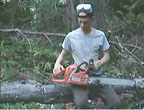
This project is part of Cary Peppermint and Christine Nadir’s series of performance-art videos begun in 2002. Peppermint is an artist who works with new media technologies to create networked environments incorporating the internet, physical installations, experimental music and sound, and live performance. Until recently, Cary directed the Digital Art and Design program of Hartwick College, and in Fall 2006 he will assume the digital media position at Colgate University's Department of Art and Art History. Christine Nadir teaches literature at State University of New York College at Oneonta and is a doctoral candidate at Columbia University where she is completing her dissertation. Its working title is “The Future of the World: Sacrifice, Economy, and Ethics in Environmental Literature and Ecocriticism.”
Christine feels that these videos capture some of the energy, activities, and thoughts that she and Cary have experienced as New Yorkers living in the wilderness for four months every year: trying to establish a functional home without running water, electricity, or maintained roads; developing relationships with locals; un-learning the romanticization of nature while re-learning humanity’s dependence on the environment for survival; and researching the details of the history of the land and the surrounding area (its previous deforestation, its logging, its near use for an auto salvage yard, its use as farmland and grazing ground one hundred years ago, the precolonial possession by Native Americans for centuries before that).
Cary says: The North American concepts of wilderness are informed by nationalist ideologies and concepts of freedom as a wild, un-checked frontier of possibility. I don’t believe there is any such thing as wilderness as we Americans are inclined to see it. How could one know or understand that which is truly wild much less employ it toward nation-building? Also, I find a certain intellectual humor in the offering of performances that purport to be both practical and wild.
Posted by jo at 12:48 PM | Comments (0)
May 05, 2006
MIT List Visual Arts Center

Art + Technology
Currently at the MIT List Visual Arts Center, Cambridge, Massachusetts: 9 Evenings Reconsidered: Art, Theatre, and Engineering, 1966; Choreographic Turn: Daria Martin; Peter Welz in collaboration with William Forsythe; and Chris Doyle: Recent Video Works
9 Evenings Reconsidered: Art, Theatre, and Engineering, 1966, Curator: Catherine Morris.
This exhibition, organized by independent curator Catherine Morris, takes a fresh look at 9 evenings: theatre and engineering, a series of performance events organized by Billy Klüver, a Bell Laboratories engineer, that took place at the 69th Regiment Armory in New York from October 13-23, 1966. 9 evenings featured ten artist/engineer collaborators who attempted to realize previously unattainable creative projects. 9 Evenings was a significant turning point for many artists who became aware, many for the first time, of the implications that advancements in technology had for the development of their own work. The exhibition 9 Evenings Reconsidered: Art, Theatre, and Engineering, 1966 includes works of art, ephemera, drawings, film, and photo documentation of the 1966 performances.
The artists involved in 9 evenings: theatre and engineering were John Cage (composer); Lucinda Childs (dancer and choreographer); Öyvind Fahlström (painter and author of theater pieces); Alex Hay (painter and choreographer); Deborah Hay (dancer and choreographer); Steve Paxton (dancer and choreographer); Yvonne Rainer (filmmaker, dancer and choreographer); Robert Rauschenberg (painter and choreographer); David Tudor (musician and composer); and Robert Whitman (film/video artist, author of theater pieces). Bell Laboratories’ Billy Klüver brought these artists together and paired each artist with an/a Bell Labs engineer to create new works. Engineers included: Per Biorn, Cecil Coker, Ralph Flynn, Larry Heilos, Peter Hirsch, Harold Hodges, Robert Keronski, Jim McGee, Robby Robinson, Herb Schneider (MIT Class of 1948), Fred Waldhauer, Witt Wittnebert, and Dick Wolff.
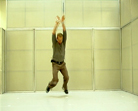
Choreographic Turn: Daria Martin; Peter Welz in collaboration with William Forsythe, Curator: Bill Arning, MIT List Visual Arts Center.
This exhibition features a 16mm film entitled Soft Materials by Daria Martin, an American artist living and working in London, and a large five-screen video installation entitled whenever on on on nohow on / airdrawing by German artist Peter Welz in collaboration with celebrated dancer/choreographer William Forsythe. In bringing together the work of these artists, curator Bill Arning offers audiences the opportunity to consider the space between dance and moving image in contemporary art practice. There is a growing history and cultural practice of choreocinema, or dance on film/video, a hybrid art form that offers previously unavailable experiences of dance. Choreographic Turn celebrates this exciting shift in cultural practice by showing two recent extraordinary iterations of this new form-film/video installations offering new modes of experiencing the art of bodies in motion.
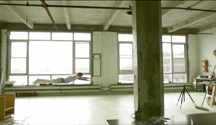
Chris Doyle: Recent Video Works
Flight (2005) 31 seconds
Tower (2005) 4 minutes
Hotel Bernini I (excerpt) (2004) 2 minutes, 33 seconds
Watershed (2004) 3 minutes, 02 seconds
Extraordinary Perceptual Dilemmas and the Madness of Climbing (2003) 1 minute, 30 seconds
Chris Doyle's themes are drawn from the psychology of everyday life. By using only the most low-tech special effects, he transforms everyday images into short films that are magical and moving.
Doyle is perhaps best known for Leap , a public artwork sponsored by Creative Time in April, 2000, for New York City's 2 Columbus Circle. A celebration of hope, Leap , showed moving images projected onto a tall building of various New Yorkers from all five boroughs jumping skyward. Beginning at dusk, depictions of a continuous stream of New Yorkers appeared at the base of the building, and one by one, four hundred and twenty jumpers soared up the height of the facade, slipping into the night sky.
In recent years, Doyle has worked less in the public sphere, and more in the private fictional spaces he creates in his videos. This selection of videos shows a wide range of Doyle's interests, but each manifests a dreamlike vision in which the quotidian becomes extraordinary. Doyle likens his practice to a "Pathetic Magician, a sad sack trying to make magic out of what is at hand."1 Writing in Art News magazine Linda Yablonsky said "(Doyle) has cast hot dogs, red bricks, and lawn chairs as human surrogates in videos that constantly mix storytelling with abstraction." 2
Flight (2005) shows the artist doing aerial circuits in a Superman pose around his Brooklyn studio before heading out the window. Today, when even amateurs have access to Hollywood-quality special effects, the artist's goal is clearly not a seamless effect. The jerky motion is left as a clue to his methodology, in which the artist performed 230 individual leaps and then sequenced the still photographs to depict flight.
Tower (2005) uses an animation technique known as "claymation". Doyle has turned the descriptive form upside down; and we see the effects of unseen artist's hands on the tower, wounding and suturing the form. and twisting it like taffy.
Hotel Bernini I (2004) is among Doyle's most evocative works, in that how one perceives the turbulence of the white hotel sheets will invariably be affected by one's own psychology. Whether it is understood as the result of anxiety, insomnia, or passion, the sheets are now vacant, and the bodies that gave them life are now missing.
Watershed (2004) shows a partly deconstructed bank building that the artist found in upstate New York. Using only flashlights for special effects, Doyle uses the skeletal frame as a metaphor for the psychological structures that contain thought, with the flashes of light serving as the events or perceptions that define human relationships. The artist appears at the very end sweeping up after the emotional fireworks.
Extraordinary Perceptual Dilemmas and the Madness of Climbing (2003) was a site specific project done for an exhibition in East Hampton, Long Island, NY. Like many natural paradises that have become popular resorts, longtime residents describe the area's past in idyllic terms that are too dreamy to be true. The old movie feel and the slightly horrific over-profusion of images are meant to conjure the dark side of paradise.
Posted by jo at 10:51 AM | Comments (0)
April 23, 2006
Garrett Lynch and Frederique Santune
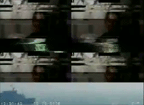
Three Collaborative Networked Videos
Collaboration for artists can be one of the most productive endevours. It produces work by the artists involved which would have unlikely been produced individually and also obliges the artists to make conceptual compromises they might not usually have to. It frees up the creative spirit as each artist realises at a point that they have to let go of their single vision to accommodate the thinking of the other. The OTHER is the crucial element in collaboration, it not alone designates the other artist but also implicates the unseen, inexperienced, unknowable, unthinkable and inconceivable of the former
Under this framework Garrett Lynch and Frederique Santune would like to announce the release of three networked performance video collaborations entitled Grimace, C.a.r.n.e.t. . .d.a.b.o.r.d, and Looping Portrait #1. Each work was performed live employing multiple digital video cameras networked and mixed through a camera security system.
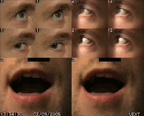
Grimace is a studio based performance employing three digital video cameras networked to a multiple camera security system. The two faces displayed are a reconstruction of artist Garrett Lynch's face. Two camera video his eyes while the third camera videos his mouth. The live feed of each of the eyes are then used eight times with a set of four right eyes on the left of the screen and a set of four left eyes on the right of the screen. Two identical live feeds of the mouth are displayed below each set of eyes. The resulting composition is of two faces bearing a close resemblance yet differing slightly, reacting, grimacing, to some unseen event or in response to each other.
C.a.r.n.e.t. . .d.a.b.o.r.d: C’est l’histoire courte d'un passage: du pareil au même. Quand le doute devient errance, la voix se perd.
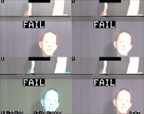
Looping Portrait #1 is an accidental portrait of artist Frederique Santune produced during setup of a studio based performance. It consists of two digital video cameras networked to a multiple camera security system which mix's them live to a single digital video deck. The cameras are off-sync with the security system resulting in distortion, regular loss of signal and a progressive scanning of the video from right to left. This effect combined with the figures movement create potential for an infinite and seamless video portrait.
Posted by jo at 01:53 PM | Comments (0)
April 19, 2006
Roch Forowicz's
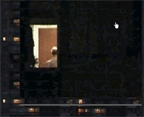
Environment
Environment is a continuation of Roch Forowicz's Invigilate project [Spotlighted on Turbulence in 2005]. It's a networked space in which every member of the project is able to connect with every other member via video, phone and/or e-mail. Environment is open to everyone though Forowicz has specifically invited residents of the apartment complexes surveilled in his Invigilate project.
I hope this space will be much more friendly for them to dialogue. Goal of this action is to create a natural, organic and free from propaganda space of the information exchange.
Environment grew out of Forowicz's perceived "failure" of the earlier project Invigilate--a form of art activity performed in a public space. Invigilate addressed the ever increasing lack of privacy in society, and questioned relationships between people sharing the same space, both social and political. Forowicz recorded people going about their lives in their apartments; he then posted the videos on the Internet and made his email address available to viewers. Forowicz also posted flyers about his activities in each of the apartment complexes; they displayed the Invigilate web site address as well as pictures of the surveilled apartments.
Forowicz's goal was to provoke a dialogue about performed surveillance and the invasion of his subjects' privacy. Unfortunately, nobody responded at first; later he received a few emails from people who didn't understand his actions at all. Forowicz concluded that he needed to encourage people to engage in a dialogue. Environment is the outcome.
Posted by jo at 11:16 AM | Comments (0)
Attention Please!
![]()
An Attention Seeking Video Installation
Artist Sara Smith and technology partner Kisky Netmedia are creating Attention Please! An Experiment - attention seeking video designed to measure attention.
Is it possible to measure our impact on space and on art? The attention Please! experiment attempts to answer this question using RFID (Radio Frequency Identification) technology. Audience members, visitors, participants, and collaborators pay attention with their an Attention Card to a piece of video. If you pay more attention, does it work harder to keep it? Other videos may feel neglected and try to attract your attention away; your attention is valuable after all.
Its focus is on manipulating the relationships between art, technology and audience, within and outside of a gallery environment. The concept centres on Sara's aim to explore the notion of presence, aura, and attention and uses emerging and everyday technologies to reveal some of these subliminal and emotional notions.
We live in a world where many services, products and people are continually competing for our attention. Each day our attention is attracted and divided; what to wear, where to eat lunch, where and how to party the night away. We are faced with images, stories, emotions all around us, on billboards, radios, and TV screens. Can our attention be turned within a gallery? What happens if we pay attention to some art more than other art? Will it know? Does it matter? It does now!
The experiment asks nothing more than for you, the audience to give your attention. Pay attention at The Box, FACT, 88 Wood Street, Liverpool, L1 4DQ. 03 & 04 May 2pm - 6pm.
Attention Please! An Experiment is a research project supported through ITEM, the Foundation for Art and Creative Technology¹s research and development programme for new media tools. ITEM is supported by NESTA and Arts Council England.
Posted by jo at 10:24 AM | Comments (0)
April 09, 2006
live broadband tv

Exploding Television
Exploding Television is a live internet broadcast during Rotterdam Film Festival. Talks, Workshops, documentation of the Exhibition, and Artist Works can be seen in the archive.
See the streaming video of the DIY_tv session focusing on the growing phenomenon of independent microTV broadcasters.
The Italian microTV movement, Telestreet, started as a loose group of TV micro-broadcasters that first went to air in Italy in 2002 in a neighborhood station based in Bologna. These loosely affiliated broadcasters share an enthusiasm for exploring the socializing power of free-to-air video (TV) broadcasting. Often their content is sourced from the independent content archives such as V2V and the Italian viral video distribution project NGV. However, in the words of their manifesto, "Television must be considered a new prosthesis and an extension of the net [...] the horizontally of the net must meet the 'socializing' power of television."
In the words of David Garcia "[Telestreet] are squatting the shadows or blank spots which terrestrial broadcasters cannot reach." They not only make their own content, but also their own transmitters and antenna. Dedicated to the socializing power of broadcast television, the project has provided an important inspiration for many Italian media activists, and has fueled a movement dedicated to the development of critical approaches to localized production and distribution of TV.
Posted by michelle at 02:26 AM | Comments (0)
March 01, 2006
TRANSMEDIA :29:59: Grafik Dynamo and Mario Trilogy
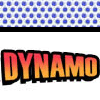
Media Art in Public Urban Space
March 1 - 31, 2006: 29th minute: Myfanwy Ashmore - Mario Trilogy; 59th minute: Kate Armstrong + Michael Tippett - Grafik Dynamo--Yonge-Dundas Square, Toronto.
Year Zero One is pleased to present TRANSMEDIA :29:59, a year long exhibition on the pedestrian level video billboard at Yonge-Dundas Square in downtown Toronto. Launched August 1st 2005, TRANSMEDIA :29:59 features one minute video works 24/7 every half hour on the 29th and 59th minutes. Featured for the month of March is Myfanwy Ashmore's Mario Trilogy and Kate Armstrong + Michael Tippett's Grafik Dynamo.
Kate Armstrong + Michael Tippett’s Grafik Dynamo is a net.art work that loads live images from blogs and news sources on the web into a live action comic strip. The work is currently using a feed from LiveJournal. The images are accompanied by narrative fragments that are dynamically loaded into speech and thought bubbles and randomly displayed. The work takes an experimental approach to open ended narrative, positing a new hybrid between the flow of data animating the work and the formal perameter that comprises its structure.
Myfanwy Ashmore's Mario Trilogy is three hacked versions of the original Super Mario Brothers video games dumped to single channel video output for Transmedia :29:59. 'Mario Trilogy' is part of the 'CONTROLLER: Artists Crack the Game Code' exhibition at InterAccess Electronic Media Arts Centre from February 24 - March 25, 2006.
TRANSMEDIA :29:59 is curated by Michael Alstad + Michelle Kasprzak
Year Zero One gratefully acknowledges the Ontario Arts Council,Yonge-Dundas Square and Clearchannel for their support of Transmedia :29:59
YEAR ZERO ONE is an artist run site which operates as a network for the dissemination of digital culture and new media through web based exhibitions, site-specific public art projects, an extensive media arts directory and blog.
Posted by jo at 10:36 AM | Comments (0)
January 31, 2006
Michael Szpakowski

Scenes of Provincial Life
Hi,
I've been making little movies since 2003 now & there's nearly 100 of them. In the meantime vlogging has really taken off, so it seems like a natural thing to present the sequence so far in this format, with any new ones I make in the meantime interspersed amongst the old. For about the next hundred days or so I'll post pretty much everyday and afterwards as and when. You can see the first six (two of which, 'bicycle' & 'counting -cell phone and strings remix', are new) at http://www.somedancersandmusicians.com/vlog/ScenesOfProvincialLife.cgi
If you've enjoyed my work in the past, &/or you like what you see here, maybe you'd like to subscribe: http://feeds.feedburner.com/ScenesOfProvincialLife
best
michael
Posted by jo at 11:50 AM | Comments (0)
January 30, 2006
Jason Bruges Studio
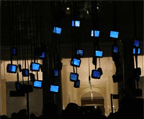
PSP Image Cloud
Unique content was driven through a PSP and split across an array of organically arranged screens.
...Jason Bruges Studio created a chandelier (PSP Image Cloud) with 50 small TFT screens hanging from it. They created video content for a PSP, which was then broken up via a grid on to each of the small screens. The PSP video was then fed into a computer, where Isadora software was used to split the signal into components, through multiple outputs and up to the chandelier. Here are my Flickr Photos and a quick poor quality video (962kb).
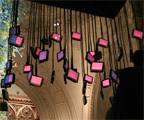
Also Playstation promotions staff were on hand to give you a demo of the PSP, plus lending out PSPs to play with exclusive content. Designers Intro were running a workshop studying unconcious explorations of mind mapping and thought patterning. There were animation screenings and short films, plus four literary walks through the V&A organised by Zembla Magazine.
Missed it? BBC2 were filming and will be showing the event on the Culture Show, Feb 16th at 7pm... [blogged by Chris on Pixelsumo]
Posted by jo at 03:04 PM | Comments (0)
The Perpetual Art Machine
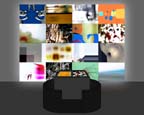
Invitation to Participate
Cinema-scope and IFAC are seeking video art submissions for: PAM - The Perpetual Art Machine to be premiered as a featured project at the -Scope New York Art Fair March 10-13, 2006.
PAM is an interactive video display installation and network designed to aid in the curatorial process by allowing artists and the viewer to play a more active roll in its outcome. PAM is an international survey of cutting edge and progressive film, video and new media art. PAM is looking for looking for screen based works up to three minutes in length and created after 2001. Writers and Curators encouraged to take part as well. Deadline: February 20, 2006, sooner the better.
Step 1: Register at http://www.perpetualartmchine.com. Once you have received your confirmation you will be able to set up your profile (contact, bio, etc) and have access to other community tools in the site.
Step 2: Submit Your Video
NTSC video only (Quicktime .MOV or .MPEG or DVD)
Best case rendering:
Quicktime, 16-bit Integer (Big Endian), Stereo (L R), 44.100 kHz, Photo - JPEG, 720 x 480, Color, Medium Quality, 15fps.
Include five keywords that describe your piece. Please have disk and materials properly marked with artist name and artwork information, Name, year, duration.
There are three ways to submit your video.
Mail your on CD or DVD to:
Lee Wells (IFAC) c/o NYCRS
462 Broadway Suite 540
New York, NY 10013
T 917 723 2524
OR
Email us a link to your high resolution video at perpetua[at]perpetualartmachine.com. Please include the five keywords describing your piece
OR
Login to post your video directly to the Perpetual Art Machine website.
Please include a self addressed stamped envelop if you would like your entry returned.
Please contact us if you have any question at perpetua[at]perpetualartmachine.com or by phone at 917 723 2524.
Lee Wells
Brooklyn, NY 11222
http://www.leewells.org
917 723 2524
Posted by jo at 10:01 AM | Comments (0)
January 10, 2006
The Unseen Video
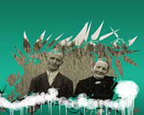
Weather Controlled Video
The Unseen Video is a weather controlled music video for Mike Milosh's You Make Me Feel. The video is affected by the weather and local time of the viewer's localisation. Every little change in their environment ensures that they will never see the same video twice. The look of the video might slightly change within an hour, but will have a whole new character in a few months. More screenshots.
By Daniel Scheibel and Ferdinand Weinrother. Weather-related installations: the Cloudharp, weather report. [blogged by Regine on we-make-money-not-art]
Posted by jo at 08:24 AM | Comments (0)
January 06, 2006
Shahram Entekhabi
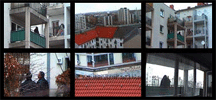
How to Perform Prayers
Fresh Azan (Quicktime), part of the installation "How to Perform Prayers," Videostills 3:04 min, colour/sound DVD/VHS – 2002/2003 (left)
The installation How to Perform Prayers--by Shahram Entekhabi--is composed of three videos, which show staged productions of existing religious rituals of the Islamic faith that differ by virtue of manipulations on the actual performing of these religious rites. The rituals presented here address the practicing of daily prayers, which Muslims are obliged to perform several times a day. Not only are these rituals compulsory for the entire Muslim world, they have remained unchanged for centuries. Through the use of disturbances, the work How to Perform Prayers pivots on the attempt to upset the collected rules of the religious canon and, in doing so, to also give weight, on a social level, to the idea of a rigidly-structured set of regulations being subject to change. All of the figures presented in the videos are women. In view of the Muslim theme this offers a new image since, in all hierarchically-structured world religions, women are discriminated against and dominated by a male-oriented image of the world – which, in itself, often encourages the Western world’s main criticism of the Islamic faith.
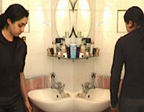
The video Wudu is based on a documentation of the cleansing ritual preceding prayer, enacted by a young woman in a household bathroom. The recorded material is doubled and assembled side by side in a way that divides the video image in two halves, thus showing two women. While on the image’s right side, the sequence of the cleansing ritual (three times the cleansing of the right then left hand, the elbows, the arms, the ears, the nostrils, the feet etc.) is faithfully captured, parallel to this, on the image’s left side, the entire sequence transpires in the reverse.
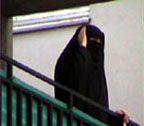
Azan is the Muslim call to prayer, cried several times a day by the muezzin of the minaret, beckoning believers to prayer in the mosque. The Azan is also used by devout Muslims when celebrating birth, in which case the call is whispered – as a rule, through a mullah – three times into the right and left ear. From that moment on, the newborn child belongs to the religious community. In the work Fresh Azan, a woman shrouded in a tschador appears on the balcony of a multistory apartment building, and sings a German-language version of the Azan. While her cries echo over the rooftops of the surrounding houses, catching the attention of passers-by, her call to prayer is accompanied by a male voice that whispers the Azan in Arabic.
Salath is actually the principal prayer of the Muslim world. It praises not only the glory of Allah, but also the absolute faith of believers and their allegiance to religious rules. Heard in the video is the voice of an old man of Iranian origin, the father of the one praying, reciting the prayer to his daughter. In the picture frame, one sees the young woman wearing the tschador kneeling on the prayer rug. She makes a great effort to repeat the Arabic words so foreign to her, and tries to assume the correct position with her body. Occasionally she interrupts the prayer and asks her father, in German now, to speak slower – or to repeat the words she finds hardest to remember. The woman’s actions oscillate between her allegiance to religious rules through sheer imitation and her rebelling against preordained rules of conduct, and the somewhat respectful tone used with her father belies her stifled laughter over the absurdity of the situation.

The video installation is supplemented by a Flash-generated animation entitled The Right Way To Pray, which, with explanations, leads through various instructional chapters on the underlying, prayer logic of the Islamic faith. Using the most advanced technologies, and a modern design, the viewer (at first an Internet user) is offered a comic-book-style and deliberately humorous, learning film. In combination with the videos, Sharahm Entekhabi once again interrupts, with this “ready made,” the rigid way of seeing, the so-called “western-oriented” gaze, directed Islamic culture. These works offer an unaccustomed and alternating glimpse at both the practice of daily prayers and the Muslim reality, but without falling prey to obsessive explanations. The artist playfully creates “counter images” which deliberately avoid exploring the exotic element in cultural differences; instead, these differences are questioned and presented here as unstable constructions.
Antje Weitzel, Berlin based curator
Posted by jo at 09:43 AM | Comments (0)
December 14, 2005
BOULDER - SCOTTSDALE - SYDNEY - WWW

24 HOUR COUNT: "a blog jam"
The 24 Hour Count is a multi-media blog band made up of Colorado artists Mark Amerika, Rick Silva, and Nathaniel Wojtalik. For this newly commissioned 24-hour online blog performance, the artists will use a variety of media including the Internet, mobile phones, digital video and photo cameras, mini-disk recorders, musical instruments, and many computer software programs to improvisationally remix, interpret, and respond to current events while filtering their "digital readings" through the prism of Count Lautréamont's "Songs of Maldoror," a classic French text written in the 19th century and whom the Surrealists adopted as the progenitor of their significant 20th century movement.
Sponsored by the Scottsdale Museum of Contemporary Art, the Alt-X Online Network, and the TECHNE lab at the University of Colorado at Boulder, the artists performing this distributed multi-media blog performance will be located in three different locations: Sydney, Australia, Boulder, Colorado, and Scottsdale, Arizona.
The event starts December 17th at 14:00 MST/Arizona; 16:00 EST; 21:00 London; 22:00 Berlin; December 18th, 08:00 Sydney.
For 24 hours straight, the three distributed artists will use the same blogging website as the virtual location for their ongoing multi-media jam session. The performance will coincide with the opening of the SOUTHWEST.net:Techno show in Scottsdale, and a living archive of the blog jam site will remain online both in the gallery through May 14, 2006, and on the web throughout the duration of the exhibition and beyond.
Posted by jo at 10:08 AM | Comments (0)
November 15, 2005
Somewhere between here and there
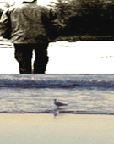
narrativas contadas narrativas vividas
"Storytelling relies on the combined human strengths of memory, imagination, and communication. The forms and methodologies of storytelling allow us to sift through and make sense of happenings in our own lives and in the lives of others. Whether drawn from representations of reality or shaped as fantasy worlds, stories tap into and represent the collective psyche of our culture. For the human being, story-making and story-listening are both a pleasure and a privilege." -- "Desire versus Destiny: the question of payoff in narrative," Glorianna Davenport, Barcelona, Spain, January 29, 2005
somewhere between here and there narrativas contadas narrativas vividas--by Alicia Felberbaum--is an interactive video installation, designed to be shown as a live, presentation in a gallery environment as well as for Internet viewing and interaction.
Somewhere between here and there, narrativas contadas narrativas vividas experiments with aesthetic and theoretical forms assigned to the documentary genre and also focuses on the potential of ’soft-linked’ stories (stories that are linked through software devices) when computers are added to the storytelling process, through algorithms applied to an array of elements [images, audio and video segments] stored in a database.
Different people were interviewed and videoed, their stories were then fragmented and embedded within the interactive work. It features people from diverse contexts, investigating spaces, experiences and struggles surrounding migration and exploring their psychological and physical journeys, and portrays the perception of the migrant experience by migrants themselves as a complex and multidimensional phenomenon. Migrants become the historians of their own lives with their own voice.
As well as documenting stories, the work allows to create associations within those stories and other visual material combined ‘on the fly’, generating a range of alternative frameworks. These frameworks are dynamically generated based on the interaction between the author’s definitions, the choices of the navigator and the matching algorithm embedded in the program. Unlike a traditional documentary, there are deviations in story directions. The author does not solely control “what happens next”; instead, that task is for the machine and the audience to navigate together.
Developed by an interdisciplinary team from London and Buenos Aires; directed, written and produced by Felberbaum [UK] and an Argentinian IT team lead by José Broide in Buenos Aires.
Jose Broide, is an IT project manager who holds a Master in Electronic Engineer from Buenos Aires University Argentina. As an IT project manager he has participated in industrial and educational software projects. He has also has been involved in software developments for art installations designing and directed the development of the software platform for this work.
Biography
Alicia Felberbaum is a new media artist living and working in London, she was born in Buenos Aires, Argentina. In 2001 she was honoured with the prestigious NESTA’s Fellowship. http://www.nesta.org.uk/ During the first two years of the Fellowship she was affiliated to the Goldsmiths Digital Studios, Goldsmiths College, University of London. MA graduate of Goldsmiths College, with honours in 1996, she has exhibited art works internationally; Midlands Art Centre, Birmingham, UK; IMA, Institute of Modern Art, Brisbane, Australia; Piece Hall Art Gallery, Halifax, UK; Pitshanger Manor Gallery and Museum, London; Angel Row Gallery, Nottingham, UK; De Oude Kerk, Amsterdam: Axis, Foundation, Netherlands; transmediale 99 - international media art festival, Berlin, Germany; Conseil des Arts textiles du Québec, Toronto, Québec and Montréal, Canada; 1998, Studio XX's 2nd Annual International Festival of Web Art, Montréal, Canada; Lovebytes Digital Arts Festival, Sheffield, UK; International Triennale of Tapestry, Lodz, Poland; U.C. Davis Design Gallery, California, USA; Camden Arts Centre, London; On Gallery, Poznan, Poland; and earlier in 1997 UNCUT-Interaction, ICA, London. _ She participated in numerous conferences including Viper Basel, 2004, International Festival for Film Video and New Media, Switzerland; 2001 DAC International Digital Arts and Culture Conference Brown University Providence, Rhode Island, USA; CADE 2001 Digital Creativity Glasgow, Scotland and Ordinatrices/Computers-International Conference, 1999, McGill University Montreal, Canada. _ She has received all levels of grants, awards and artist residence to support her work including from Nesta, National Endowment for Science, Technology and the Arts; Award for the Research Exchange Scheme from the Arts and Humanities Research Board in collaboration with Science Communication Group, Imperial College of Science, Technology and Medicine, London; transmediale 99 Award - international media art festival for Internet projects, Berlin, Germany; Awards to Individual Artists, London Arts Board, UK; in 1998 she was commissioned for a collaborative public Internet project, as part of the Photo 98 Public Sightings Program; she was Artist in Residence at Artec, Arts Technology Centre, the first independent centre in the UK dedicated to creative applications of digital technology and in 1997 she was artist in Residence, Camden Arts Centre, London. [via Rhizome]
Posted by jo at 08:15 AM | Comments (0)
October 24, 2005
Balance and Power:
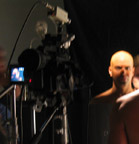
Performance and Surveillance in Video Art
Balance and Power: Performance and Surveillance in Video Art: At a time when the nation is preoccupied with heightened security and surveillance, and the public is fascinated by Reality TV with its open and surreptitious video exposure of participants, the boundaries between performance, voluntary acting for the camera, and surveillance, involuntary recording on camera by power systems with an interest in the movement of citizens, become blurred. Since the earliest days of video art in the mid-1960s, artists have negotiated the question of when surveillance becomes performance (and vice versa) and these concepts continue to be central to many video artists working today. This exhibition, which examines both the early days of video art and current practices, is an attempt to understand the complex relationship between the issues of performance, surveillance, and power.
Included in the exhibition are works by some of the earliest practitioners, large-scale installations, newly commissioned pieces, and the premiere of Jordan Crandall's new film, Homefront. Balance and Power will be installed in two locations: in public areas at the Thomas M. Siebel Center for Computer Science and at Krannert Art Museum. The Siebel Center regularly features contemporary art installations employing state-of-the-art equipment integrated into the building. Installations at the Siebel Center periodically may be unavailable. Guest curator: Michael Rush.
"...In the earliest days of video art in the mid-1960s, artists engaged the question of when surveillance becomes performance and vice versa. This issue remains central to the work of many video artists today, said Rush, a writer, curator, critic and former director of the Palm Beach Institute of Contemporary Art in Lake Worth, Fla.
The exhibition references and features work by a diverse group of artists, from early video pioneers such as Andy Warhol, Vito Acconci and Bruce Naumann to emerging practitioners such as Jill Magid and U. of I. art and design professor Kevin Hamilton.
Other participating artists are Antenna, Sophie Calle, Jim Campbell, Peter Campus, Jordan Crandall, Shelley Eshkar, Harun Farocki, Subodh Gupta, Tiffany Holmes, Tim Hyde, Paul Kaiser, Kristin Lucas, Steve Mann, Jenny Marketou, Jonas Mekas, Muntadas and Marshall Reese, Martha Rosler, Julia Scher, Kiki Seror and Gregory Shephard..." More >>
Posted by jo at 03:35 PM | Comments (0)
October 15, 2005
odys
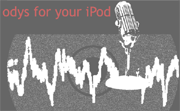
a non-linear video art series for iTunes and iPod
odys for your iPod is an extension of Nathaniel Stern's odys series, 2001-2004. The odys series consists of six short digital video poems/monologues for small screen viewing in an intimate gallery space. By stuttering between odys' actions and words, listeners construct his person. As he attempts to re-member, bringing the past back to his body and calling it his own, listeners attempt to piece together a story for themselves. Viewers are encouraged to re-visit and jump over juxtaposed media, and create a shifting collage of, and in response to, his person.
![]() odys for your iPod encourages viewers to download all six of the newly optimized video art pieces from odys.org, and into iTunes and their iPods. It allows for an even more intimate and physical relationship with his character, as well as a continually growing connection with each vignette.
odys for your iPod encourages viewers to download all six of the newly optimized video art pieces from odys.org, and into iTunes and their iPods. It allows for an even more intimate and physical relationship with his character, as well as a continually growing connection with each vignette.
odys' name comes from The Odyssey; he is the traveler, the seeker of home (Ithaca). Contrary to both Odysseus and hektor, odys is an unconvincing liar and horrible storyteller. His failed attempts to speak the traumatic past are often mistaken for nonsense. Ironically, odys’ poor endeavors at communication can now be largely consumed by a take-away transmission: online. odys' language of utterances is about the "spaces between." The space between words, between articulation and inarticulation, between Troy and Ithaca, between judgment and responsibility, and between speaker and listener.
Posted by jo at 11:29 AM | Comments (0)
October 01, 2005
TRANSMEDIA :29:59
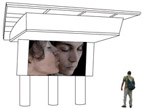
media art in public urban space
Year Zero One is pleased to present TRANSMEDIA :29:59, a year long exhibition on the pedestrian level video billboard at Yonge-Dundas Square in downtown Toronto. Launched August 1st 2005, TRANSMEDIA :29:59 features one minute video works 24/7 every half hour on the 29th and 59th minutes. Featured for the month of October is Risa Horowitz's 'Studiopace' & Honeybytes 'Bleury'.
Risa Horowitz's Studiopace is a 60 second video in honour of those thoughtful moments an artist has alone in studio, and the hustle and bustle of passersby at Yonge and Dundas in Toronto's downtown core. A bit of corresponding banality, of killing time, of getting somewhere on important business, of getting nowhere at all, and an homage to Bruce Nauman's old studio experiments conducted partially out of boredom and a love for absurd repetition.
Honeybyte's Bleury is a layering of two different video sequences, which juxtapose perceptions of the urban landscape and the innocent yet inquisitive eyes of children.The first sequence keeps in mind the site-specific nature of the work. It documents a night at the intersection of Ste. Catherine and Bleury streets in Montreal, where the commercial and entertainment districts collide. The sequence captures the aesthetic of Montreal's urban landscape. Lights, cars, billboards and people infuse the landscape and overwhelm the senses. The second sequence, which is layered over the first, is of school children in a garden looking deeply into the camera lens. Their gazes are filled with naivety, and yet seem to convey an energetic and mischievous curiosity
YEAR ZERO ONE is an on-line artist run centre which operates as a network for the dissemination of digital culture and new media through web based exhibitions, site-specific public art projects, an extensive media arts directory, and the Year0.
Posted by jo at 09:41 AM | Comments (0)
September 13, 2005
MusicGrid:

A Case Study in Broadband Video Collaboration
"ABSTRACT: The technical requirements for widespread deployment of broadband video over the Internet are rapidly being met. But a harder challenge remains: how can video–based technologies promote collaboration and learning?
We present a case study: the MusicGrid Project. Running from 2002 to 2004 with partners in several Canadian and international locations, this modestly funded initiative ran over one hundred successful multi–site education and performance sessions. The rationale, development, and operation of the project are discussed, along with general lessons learned. We believe that our experience and the opportunities and issues identified will be useful to all those interested in large–scale, video–based collaboration projects." From MusicGrid: A Case Study in Broadband Video Collaboration by Hassan Masum, Martin Brooks, and John Spence, First Monday, Volume 10, Number 5 — 2 May 2005.
Posted by jo at 09:56 AM | Comments (0)
September 01, 2005
Jumping Rope
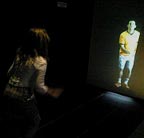
Action Driven Narrative
Jumping Rope is the classic children's game of jump rope transferred into the digital world. Your skill at jumping an invisible rope determines the course of a film narrative. You have to stand between two projection surfaces that each display a different figure holding a jumping rope. You can see on the screen how they are turning the rope but you have to mentally see the rope in order to jump on time. Your talent at jumping is evaluated by a video camera equipped with motion-tracking technology.
If you're good at it, the characters are encouraging and play with you. There are three different scenarios played by three different couples. The installation offers a simulated life situation in which you, as an adult, suddenly realise that your behaviour is pruned through a haunting invisible rope by the people around you (your parents, colleagues, boss, etc.), that you might be "trapped" between two characters or still be dancing to someone else's tune.
In Jumping Rope, the participant becomes a part of the cinematic situation and their jumping enables the scenario to progress and the plot to develop. A work by Portugaly Orna, Talithman Daphna, Younger Sharon (who also made Heartbeats). Video. [blogged by Regine on we-make-money-not]
Posted by jo at 06:00 PM | Comments (0)
July 30, 2005
Why Bother
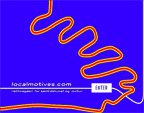
Live Video Streaming from Artists' Studios
During the autumn of 2005, Localmotives will be organizing a project which aims to stream live video imagery from several artists' working spaces (aka «studios»). The project is named Why Bother and will be produced in collaboration with i/o/lab and Atelier Nord. The video streams will be part of localmotives' 11th themed publication. The publication is titled 1:1 and will be physically manifested at Rogaland Art Centre (Rogaland Kunstsenter) from the 15th of September to the 27th of November.
We would like to get in touch with artists who already enjoy a high bandwidth connection to the internet, and would like to participate in Why Bother. You don't need to know a lot about video streaming. We will provide the technical assistance to make things work.
There are no million euro cheques to win here, but on the other hand you won't have to behave like an ass. We expect you to do the things you'd usually be doing, and you don't have to be in front of the camera all the time. It doesn't matter whether your working space is a desk, a corner of your livingroom or a good old studio.
We hope to gather participants from a geographic area as possible. The live streams from the various studios will be displayed in steady rotation on monitors in the exhibition room at Rogaland Art Centre.
Interested? Get in touch with: Geir Egil Bergjord, geiregil[at]localmotives.com (+47 51 89 33 39/+47 922 27 616) or Kevin Foust, kevin[at]iolab.no (+47 412 97 293)
_http://www.localmotives.com_
_http://www.iolab.no_
_http://www.anart.no_
Posted by jo at 09:21 AM | Comments (0)
July 25, 2005
Cancer Cell Cam
Cancer Cell Cam: Human Melanoma Cells Growing in Culture
Posted by jo at 12:05 PM | Comments (0)
July 04, 2005
The R.g.b-project
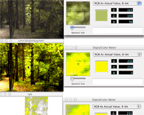
Color Walk-Through
The R.g.b-project--by Jacky Sawatzky--is an experiential project, which invites participants to interact with the city through the concepts of the RGB-color space, a color space commonly used by digital technology. Participants are asked to go on a color-walk through the city, using a video camera to document one of the three colors, Red, Green or Blue. Consequently, the created clip is inputted into a computer program the artist wrote. This computer-program acts, as a surveillance machine through only highlighting what the program 'thinks' is red, green or blue. If the program can't find the specified color, the sound of the clip is heard. Read Jacky's thesis [PDF]
Participants comment on the project as an experience that heightened ones awareness of digital technologies interpretation of color. The results of the project show that this interpretation can be dubious at times. Crucial is the difference in method each participant used while creating the clips. Some had a documentary style approach. Others perceived the instructions as a framework for a performance and some created a conceptual dialogue with the parameters of the computer program. For more information download the thesis on the project page.
Posted by jo at 07:44 AM | Comments (0)
June 28, 2005
Step + Repeat: Pittsburgh Cycle
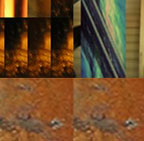
Shifting Technologies and Economies
Step + Repeat: Pittsburgh Cycle--by Carlos Rosas and Robert Dansby--Call for Participation: Submit your images of Pittsburgh. Your images will be entered into the image database and be included in the participatory tile sequence projected in the Palmer Museum and viewable on the Internet via live webcast. For more information on this project, to submit images and to view the live broadcast visit the project web site.
Abstract: A live audio and video based piece using networked media. Based on digital “step and repeat” cycles: a loose metaphor, the Pittsburgh iteration uses video and audio samples recorded in Pittsburgh, PA, and the surrounding western Pennsylvania area –with touchpoints including Primanti’s, the Strip, the Southside, East Liberty, the Northside, Beaver Falls, Jones & McLaughlin, the Monongahela Incline and Pittsburgh’s three rivers.
Divided into into six primary segments and a seventh segment including material contributed by viewers to be filtered through a digital randomizer, step and repeat: Pittsburgh cycle maps entrance into an urban environment via incline railway, transit through the city, reflections of the community’s industrial past, particularly steel, and the transformation of city and countryside as the industrial economic base shifts and nature again takes hold of old worksites. In the last two segments the viewer leaves the city, again on incline railway, and watches as the evening paints the city as a visually appealing study of water and reflection.
Concept and Development:
With a nod toward Allen Sekula’s work: specifically “Fish Story.” This piece chronicles (in a documentary fashion) the ironies, displacements, shifting values, economies and systems: the transformation of an American city as an industrial and economic center shifting from steel to telecom, and the reclamation of areas of the city and countryside dedicated to old economies/technology by both nature and the population at large - a population with new needs but retaining a core identity.
The “Step and Repeat” cycles are variable and highly dynamic works performed live with laptops or in automated modules prepared for web or installation on site. The media resources are mixed, filtered, and emitted via live performance software…deriving image, video, qtvr, audio, and net streams from databases and databanks resident on local and networked laptops and servers.
Posted by jo at 12:21 PM | Comments (0)
May 30, 2005
ResonanCITY
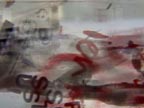
Live Audiovisual Performance
Many sounds and images in our everyday lives slip past our notice simply because they are too small, or because we lack the proper receivers to pick them up. ResonanCITY is an ongoing project to gather these microscopic sounds from various cities, and to amplify and transform them. The goal is to build a new city of sound and visuals inside the old one, and to inspire curiosity and exploration of one's own environment. Video artist Sara Kolster, searches for details and objects which she transformed in a microscopic way into macro-images. She uses different macro-lenses and a lightbox, capturing and manipulating these images live, without the use of any filters. The combination of film- and video techniques with analogue tools as found footage, positive film and photographs gives the performance a layered character.
The sound of resonanCITY is based on gathering elements which are specific to each location and reinterpreting them in a performance setting. Field recordings, found objects, folk music and spoken texts are mixed and processed live with the computer with the intention of uncovering hidden details and nuances that escape everyday perception. For some performances, the audience is encouraged to bring objects which they think might become interesting if listened to more carefully, and an improvisation is based on these objects. Quicktime movie.
Posted by jo at 12:29 PM | Comments (0)
May 19, 2005
Recycled TV

Balance and Fair Use
Ben Hanbury has created Recycled TV, a wicked video installation that remarks on ever changing copyright laws and Creative Commons.
"The concept behind this piece then is to take two groups of video clips, one group which is licenced under the Creative Commons and one group which is copyrighted but is old enough that it would be in the public domain by now if the terms of copyright had not been extended so many times. The videos will then be broken down into very short clips (milliseconds) which will then be used to form beats in various audio tracks. The user will then be able to use a retro tv interface to mix between tracks thereby forming a new creative product out of old ones, however the user will also have to make choices of balance and fair use between public domain and copyrighted material."
View a video and more work by Ben on Free Culture. He has now finished his degree and will soon been looking at job offers, so get in touch if you are interested. Nice one. [blogged by Chris on pixelsumo]
Posted by jo at 10:42 AM | Comments (0)
May 16, 2005
BlogStarTheater
![]()
Remaking Other Peoples' Blogs
BlogStarTheater is a weekly web show in which people create theatrical reinterpretations of strangers' blog entries, in video format. Anyone can produce and submit an episode, and every blog is a potential source of material. The project, an experiment in participatory mass media, is a show by everyone, for everyone, and about everyone. It was created at the Interactive Telecommunications Program, NYU, by Laura Garcia-Barrio, John Geraci, Luna Vega, Pete Vigeant, and Akio Wada. The idea is to examine the tension between blogging as a form of public diary versus blogging as a form of broadcast media. [via]
Posted by jo at 11:45 AM | Comments (0)
May 11, 2005
Omnivisu
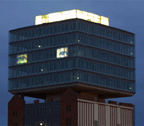
Street Art for All
Omnivisu--an urban installation by Willy Sengewald and Richard The--was designed for a facade at the S/U station Warschauer Str. which is "not only a symbol of the desolated GDR–industries. It is a relict of the new–economy boom and its ending as well as the arrival of MTV and Universal."
The tower at the the S/U station has an odd glass cube on the top and the artists decided to give it eyes. The passersby could participate by looking inside the box. Their eyes were then projected onto the glass–front of the tower, making it look like the head of a robot with ever changing and personalized eyes. The project was an attempt to make "street–art that anybody can influence and use playfully." Movie. [blogged by Regine on near near future]
Posted by jo at 11:02 AM | Comments (0)
May 09, 2005
Liquid Space
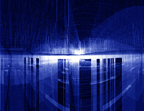
3D Navigable Platform Exhibition and Workshops
LAb[au] is happy to invite you to Liquid Space 01+02 exhibition + lqs03 workshop taking place at Brakke Grond, Amsterdam_ the Netherlands. Liquid Space is a series of artistic workshops LAb[au] is setting up with different cultural institutions to design spatial audiovisuals with a specific focus on collaborative and shared processes resulting in installations, exhibitions and performances.
Here, the space navigable music platform--a 3D engine developed by LAb[au]--is proposed as the starting-point for development and exchange to the invited artists. The engine is based on the principle of integrating different media in a structural, programmed manner, inside and through electronic space navigation. An environment where the performer navigates his created 3D space to compose music in real time, displayed in a 360° projection space and a quadra-phonic sound system.
..lqs01: deSIGNforms _ Nabi Art Center,Seoul
..lqs02: deSIGNing by numbers MediaRuimte, Brussels
..lqs03: deSIGNing feedback loop systems _ Brakke Grond, Amsterdam
..04.05 - 14.05.05: liquid space 03 - workshop
..10.05 _ 20.00 h: liquid space 01+02 exhibition opening + presentation
..11.05 - 14.05 _ 10.00 - 24.00 h: exhibition *
..14.05 _ 20.00 h: liquid space 03 closing event, performance
LAb[au] + Eavesdropper, Els Viaene, Petersonic invited by Brakke Grond to perform Exploring the Room in the context of the Liquid Space 03 deSIGNing feedback.loop systems workshop theme and as an opening-event of the Liquid Space 01+02 - exhibition.
Exploring the Room is a performance where music, best defined by the practice of soundscaping, and real time generated computer graphics stand on the same level. Establishing a constant dialog through its particular stage-design, sound and visuals are building the room, a 3.00 x 3.00 x 2.25 meters "cube" made out of projection screens and quadraphonic speaker setting, giving the minimal footprint able to host 3 musicians during 1.00 hour.
Performers and the audience are projecting shadows on the screen-walls, the system is capturing this image and reintroduce it as an overlaid projected image, closing the loop. All acting then is a matter of balance in between black and white, light and shadow, sound and silence, one and zero.
Posted by jo at 07:19 AM | Comments (0)
April 26, 2005
Taken
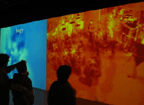
Tracing Memory
"A small enclosed gallery off of (Williams College Museum of Art's) historic rotunda, Media Field is the museum’s sacred space for video and new media work. The Toronto based artist, David Rokeby has inhabited it with his video installation Taken, specifically reformatted for the space. The work establishes a surveillance environment that monitors the room with a three-channel video projection, tracing the memory of the gallery, so to speak. Rokeby’s software responds to every visitor by focusing and recording their movements in a looped video format on three walls, leaving the center of the gallery light up and empty in wait for a performance.
That performance is your blurred image within a stream of transparent bodies flowing through the room [the day’s palimpsest of visitors] featured in the main projection. Once a new presence is detected the crowd vanishes and the new visitor is isolated in the space. Walking into the room gets you noticed – quickly- and just as quickly, you are stitched into the quilt of the gallery’s daily memory." From David Rokeby @ WCMA by Dina Deitsch, Big Red & Shiny #21.
Posted by jo at 09:28 AM | Comments (0)
April 25, 2005
lifeClipper

The Walking Experience
lifeClipper is an open air art project. It offers an audiovisual walking experience in a virtually enhanced reality. Technically it is based on portable computer equipment worn by an individual. When walking around in a chosen culturally interesting area or impressive landscape the visitor's position and viewing direction is measured by means of GPS and the found situation augmented according to defined presets. Image and sound are displayed on an HMD (Head Mounted Display). Live captured image and sound are treated in real time by altering parameters as well as by adding music (composition, spoken text and sampling of documetary material), photo and video material (documentary and fictively arranged).
Through interventions on habitual ways of listening and seeing, reality becomes questioned and day-to-day situations become an adventure. Users feel as though they are watching a film in which they participate as active observers and in which they get attention from virtual players. The borders between subjective and objective perception become blurred as the user is immersed into space and action but also contemplates artistic compositions and cultural reflections. Read a review.
Posted by jo at 09:28 AM | Comments (0)
April 16, 2005
Global Pong
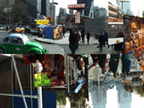
A Networked Babelogue Between Four Cities
Global Pong was a live dialogue on urbanism comparing local observations in New York City, Mexico City, Shanghai and Berlin, mediated through text fragments translated on-line into four languages. Texts were read live by a native speaker in its original language, cycled through four online translators projected as giant text banners, and then spoken again. Meanings shifted similar to a game of telephone ("teléfono descompuesto", "stille post"), and the four speakers added comments in their native language on each passing paragraph with keywords added into the translation cycle. Readers in this organic exchange of ideas included Vito Acconci, Andrés Oriard, Fu Xinian and Kai Vöckler.
Accompanying the texts were live video and sound components emanating from the four locations. Ralske created a visual interpretation/video collage from live webcam feeds. Composers in the four cities remotely contributed to a live ambient sound performance in which music files were passed along in an exquisite corpse style and "translated" similar to the textual work.
Posted by jo at 10:51 AM | Comments (0)
April 01, 2005
Video-matic.nl

Mix Your Own
Video-matic.nl is an interactive video installation by Olga Mink. The projection is visible from both inside and outside the building. Interactivity is a crucial part of this installation, and is accomplished via the Internet or a touch-screen located in the main hall. The 'spectator' is invited to create a VJ-mix that is uploaded to the server in Sint Oedenrode. An automated video database ensures an ongoing supply of images, which makes this installation a dynamic piece of work evolving over time. There is a real synergy between image, light and the environment. [via Rhizome]
Olga Mink (Visual.Girlbot.Facility) is active as an artist in the Netherlands. She obtained her MFA at the Sandberg institute (Amsterdam). Next to art-projects she is a video-performance artist. Faster than the speed of light she takes the audience to unexplored areas, and shows them her abstract visual landscapes and rhythmic image-architecture.
The technical part of the installation is realized by Jilt van Moorst (NL). Jilt Van Moorst is a software-developer and graduated from the HKU (Art, Media & Technology). He also performs as Robotfunk and developed a VJ-tool called 'Flowmotion'. This sophisticated piece of software is used by VJ's allover the world.
Posted by jo at 08:27 AM | Comments (0)
March 18, 2005
I Am Making Art Too

Jill Miller's Performance Art Video Mashup
"San Francisco media artist Jill Miller inserted herself into a seminal 1971 performance art video by John Baldessari. The original piece, itself an ironic commentary on body art, is called "I Am Making Art." Miller's update is dubbed "I Am Making Art Too." As Baldessari moves through his meditative tai chi-esque motions, Miller busts a move to the Missy Elliott soundtrack she added to the clip. According to Miller, the piece raises questions about women's roles in art history and, of course, the power of appropriation and cut-up. See article in the New Zealand Herald. [blogged by David Pescovitz on boingboing]
Posted by jo at 10:07 AM | Comments (0)
February 14, 2005
playListNetWork
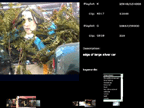
Environment for Collaborative Authoring
playListNetWork is a distributed video editing database that allows multiple users in different locations to edit and annotate media clips and playlists simultaneously. The project was initiated by artists interested in collaboratively authoring multi-threaded audio visual works. It's comprised of three parts: the playListNetWork software developed in consultation with the artists, the audio visual media content made with the software and an interface to visualize and navigate the authored structure. The application called disPlayList is the public view and interface for a streaming media work authored with the playListNetWork software. It is a web application embedded in a browser using various plugins to display media. As an interface it is used to visualize the multi-threaded playlists and provide navigation through a 3d representation of their structure. "Though playListNetWork is not performance in a real time sense - the network was used for the authoring and the display of our distributed collaboration."--Willy Le Maitre
Posted by jo at 09:38 AM | Comments (0)
February 10, 2005
Dziga Vertov Performance Group
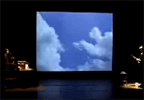
Performance Hybrids
Founded by artist/director Douglas Rosenberg in 1991, Dziga Vertov Performance Group's purpose is to create works bridging numerous disciplines including dance, performance and the visual and media arts. It takes its name from the Russian filmmaker of the early 1900's. DVPG's fundamental mission is to create new and challenging works of art based in the language of performance, dance and media that often combines voice, text, video and projected images. The work of DVPG is concerned with both content and form. The purpose of the work is to engage the audience, other artists and community groups in a dialogue that reaches beyond the usual performer/spectator relationship. In order to do this, we have set out to create a hybrid form of performance that is intended to both engage and challenge, using concepts and images that speak to contemporary and historical issues of human existence.
One of DVPG's many projects is ADaPT, an interdisciplinary association of artists, technologists and scholars from five educational institutions dedicated to research and critical dialogue on performance and media in telematic space.
ADaPT comprises five dance studios in five universities in the USA.:
1. Arizona State University
2. Ohio State University
3. University of California-Irvine
4. University of Utah
5. University of Wisconsin
In Wisconsin, the ADaPT team consists of Douglas Rosenberg (principal investigator), Chris Dowling (telematic technologist) and Jeffrey Gray Miller (technical director).
The objectives of ADaPT are to:
* create a site for telematic collaborative inquiry for the purpose of developing new models of practice and training techniques for the creation of networked dance and performance
* explore embodiment and somatic intelligence through reconceptualization of spirit, body and machine in Internet 2 culture- develop a shared mediated space for investigating performance and creative collaboration through a distributed environment across time zones
* situate research within a larger cultural and political context that acknowledges how mediated performances both frame and are framed by issues such identity, privilege, and access.
Posted by jo at 11:48 AM | Comments (0)
January 27, 2005
East by West
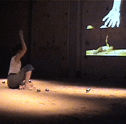
Fictional Geographies and Mediated Presences
"The concept of networked, translocal spaces allows investigation of the nature of real-time sound synthesis and how extended physical space can be shared by people when they play with fictional geographies, strange or familiar objects, and their mediated presences. Telepresence restructures and enlarges the environment with its projection (window) of mediated and combined presences in action. Linking a "local" site with a "remote" site raises particular challenges for our understanding of new artistic paradigms in telepresence, distributed and "navigational" art. The social orientation toward sensual environments and "hyperplasticity" is not directed at euphoric assumptions about virtual reality (VR) but at concrete, synaesthetic processes of cognition. East by West addresses the visitors' playful fantasy and tactile exploration of the environment; the interface becomes useful. If such play recognizes how parallel reality-systems can converge or affect each other, how we integrate other realities into our social experience."
Posted by jo at 09:44 AM | Comments (0)
January 25, 2005
In Conversation
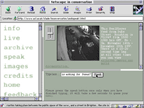
From Street to Chatroom
When live and located, In Conversation provided the means for individuals in the street and on the Internet to engage in a live dialogue with each other. This work by British artist Susan Collins aimed to examine the boundaries and social customs of distinctly different kinds of public spaces - the street and the Internet/chatroom-each with its own established rules of engagement.
Passers-by encountered an animated mouth projected onto the pavement and, through loudspeakers, could hear voices triggered by internet users trying to strike up a conversation. When the pedestrians responded, a concealed microphone and surveillance camera transmitted the responses to the website via a live video stream (webcast). Through the website, online visitors could view the surveillance video and hear the people on the street. They could type messages and send them 'live' to the installation where they were converted into speech and broadcast to the street through loudspeakers.
Posted by jo at 09:08 AM | Comments (0)
January 24, 2005
painterly surveillance techniques
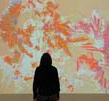
aesthetic system
Camille Utterback's interactive installation
Untitled 5 is the fifth interactive installation in the External Measures Series, which Utterback has been developing since 2001. The goal of these works is to create an aesthetic system which responds fluidly and intriguingly to physical movement in the exhibit space. The installations respond to their environment via input from an overhead video camera. Custom video tracking and drawing software outputs a changing wall projection in response to the activities in the space. The existence, positions, and behaviors of various parts of the projected image depend entirely on people's presence and movement in the exhibit area.
Untitled 5 creates imagery that is painterly, organic, and evocative while still being completely algorithmic. To create this work, Utterback first develops sets of animated marks whose parameters and behaviors are controlled by people's movements. Then, out of a working 'palette' of these animated marks, she composes an overall composition. The composition balances responses whose logic is immediately clear, with responses that feel connected to viewer's movements, but whose logic remains complex and mysterious.
Integral to the piece are the animated mark's cumulative interaction with each other over time. As a person moves through the space, a colored line maps his or her trajectory across the projection. When a person leaves the installation, their trajectory line is transformed by an overlay of tiny organic marks. These marks can now be pushed from their location by other people's movement in the space. Displaced trajectory marks attempt to return to their original location, creating smears and streaks of color as they move. The resulting swaths of color occur at the intersections between current and previous motion in the space, elegantly connecting different moments of time. This is just one of the behavioral elements of the composition.
While the specific rules of the system are never explicitly revealed to participants, the internal structure and composition of the piece can be discovered through a process of kinesthetic exploration. Engaging with this work creates a visceral sense of unfolding or revelation, but also a feeling of immediacy and loss. The experience of this work is the experience of embodied existence itself - a continual flow of unique and fleeting moments. The effect is at once sensual and contemplative.
Posted by michelle at 07:21 PM | Comments (0)
January 22, 2005
Project Molly

Light Lunch with Molly
"Project Molly is a series of roaming interactive webcasts captured live using a wearable wireless audio/video acquisition system by artist Nichola Feldman-Kiss. Please interact with Project Molly live for light lunch and conversation via internet relay chat at the Project Molly interface."
Project Molly was a performance art/research innovation; it used a Xybernaut wearable computer with a head-mounted audio video acquisition and display system to stream a live video feed to the internet via wireless connection. The prototype real net video performances interactively linked the remote audience with the real time audience/performers via Project Molly’s personal a/v surveillance and chat interaction. Each consecutive interactive webcast incrementally evolved the project molly interface and knowledge database. Ultimately, the interface tracked project molly's movement through real space and captured streamed video into a data archive that is indexed and searchable by a variety of terms.
Posted by jo at 12:16 PM | Comments (0)
January 19, 2005
Transfers

GPS+Video/Audio+You=Mobile Art
Transfers--by Matt Roberts--is a project exploring real-time generation of art and user participation in a mobile environment. Transfers allows a passenger of a taxi to generate a unique piece of art by giving the taxi driver directions. As the taxi moves through the city the passenger experiences a real-time manipulation of live exterior video and audio taken from a camera and microphone mounted in the taxi. The taxi is also equipped with a GPS that feeds an onboard computer data such as speed and direction. This computer is running custom audio/video manipulation software and uses GPS data to make decisions about how the live video/audio feed is manipulated and seen by the passenger. The manipulations of the live feed is displayed on two LCD screens and heard through the cars stereo system. As the user tells the driver where to go the passenger becomes both performer and viewer as they experience a unique piece of art generated by their decisions. The software also records this performance and at the end of the drive the passenger receives a CD with a QuickTime movie file of his or her recorded performance. [via Rhizome] Related >>
Posted by jo at 02:56 PM | Comments (0)
January 10, 2005
Public Genitals Project
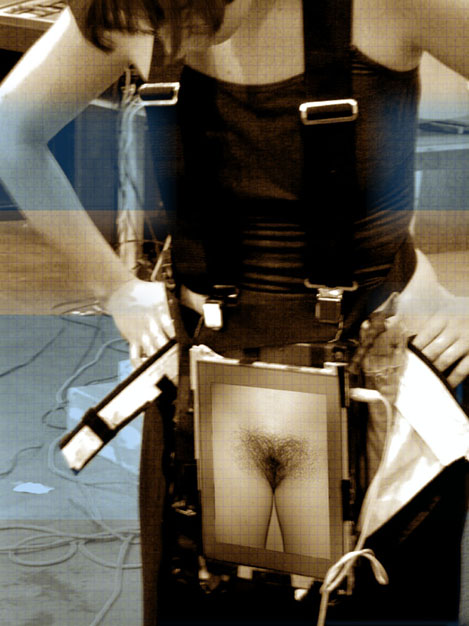
Not Safe for Walks
The Public Genitals Project , by Sandy Stone, playfully questions the boundaries between inside and outside, revealed and hidden, representation and reality.
Each PGP unit consists of a video broadcast receiver, battery pack, two small loudspeakers, and two modified laptop computers worn by a person walking the streets of Austin.
In one version, the person is naked except for the screens, which are attached to suspenders and worn so they cover the genital areas front and back. In the second version the person is fully clothed except for cutouts over the genital areas front and back, within which the two screens are mounted.
In operation, participants worldwide send images of their genital areas via webcams. The images are digitally manipulated according to an algorithm driven by the number of times the words "sex" and "violence" appear on the webpages of CNN, MSNBC, and CBS. The digital manipulation smooths and abstracts the images; the more the terms "sex" and "violence" appears in the media, the more that actual body images recede toward imagined recollections. The images are then broadcast and displayed on the flat screens. Concurrently, the loudspeakers present ethnographically recorded narratives of personal experiences with nudity, shyness, and desire, which are stored as sound files on the computers. The juxtaposition of images and physical body surface is meant to convey the illusion that the viewer is looking through a transparent electronic window at the surface of the wearer's body.
In reality, no actual flesh-and-blood genitalia are directly visible, and no explicit representation of individual genitalia is shown, though it is likely that this distinction may be lost on the naive viewer -- we hope. (Posted by Régine Debatty)
Posted by Regine at 09:19 AM | Comments (0)
December 30, 2004
Vidget 3.5

Experimental Performance Device
Vidget 3.5 is an experimental interactive audiovisual performance device which allows the user to manipulate video in real time online. As well as mixing a number of video clips together, the user may search for still images from the Flickr photo sharing site and mix them together. [via unmediated]
"...this version (Vidget 3.5) follows on from previous versions: Vidget 1; Flickr Image Viewer (Vidget 2); and Vidget 3...For instructions on Vidget 3.5 usage, see previous versions above.
Notes:
The main feature which has been fixed is the Flickr image search function. Over the last few weeks flickr.com (a very cool photo sharing site) has been changing the way they format their RSS feeds which means previous vidgets are broken. Things seem to have settled down now after a brief period of including 'enclosure' tags in their feeds I am back to parsing information from the 'description' tags for each image.
I am also back to using separate movies for the controls and output of the vidget. This improves the performance greatly as the output movie (which composites up to 3 source movies over the top of each other in real time) is rendered at 320*240 and may be increased to 640*480 by viewing at 'double size' in the Quicktime Player. I was having a lot of problems with sending the url of each of the 'source' movies from the controller movie to the output movie to be loaded. The solution was to have the output movie effectively 'ask' for the url via a custom event.
The controller movie now finds the url of the selected source movie (from either the xml file which lists the names of my clips or the Flickr RSS search response), sets it as a 'string variable' and then executes a custom event in the output movie which reads the 'string variable' back from the controller movie. The same process applies to tell the output movie which Movie In A Movie track to load the clip into.
Here's a bit of the LiveStage Pro Qscript for the controller movie:
SetStringVariable(1, channel)
SetStringVariable(2, bignumber)
SetStringVariable(4, movpath)
MovieOfID(12345).TrackNamed("Untitled Sprite").SpriteOfID(1).ExecuteEvent(42684)
The output movie then executes an event which gets these variables and sets them as 'Movie Variables':
SetString(channel, MovieOfID(838482).GetVariable(1))
SetString(bignumber, MovieOfID(838482).GetVariable(2))
SetString(movpath, MovieOfID(838482).GetVariable(4))
TrackNamed(channel).AddChildMovie(bignumber, movpath)
TrackNamed(channel).LoadChildMovie(bignumber)
Livestage Pro source files: Controller, Output"
Blogged by David Wolf
Posted by jo at 08:40 AM | Comments (0)
December 28, 2004
receptor-sculpture
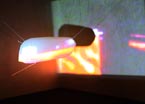
transmitting and transmuting
Tentacle (2004) from Swedish arts collaborative Beeoff (Olle Huge, Tomas Linell and Mikael Scherdin), is a receptor-sculpture on a network that feeds streamed content (“streaming media”) over the Internet to several stations.
Tentacle gathers and transmits sound and images from nodes at distributed locations, transmitting them to a central editing computer, creating new content which is rebroadcast simultaneously back to the translucent, sculptural nodes at each location. Tentacle has been exhibted abroad in Paris (Villette Numérique), Stockholm (Splintermind – the artists’ studios) and Helsinki (Kiasma Museum), and will be exhibited for the first time in the United States at Eyebeam for their Artist in residence program.
Posted by michelle at 09:33 PM | Comments (0)
December 27, 2004
netzwissenschaft
![]()
Emerging Infrastructures of All (Inter)net Research
Dr. Reinhold Grether's network research | netzwissenschaft site maps the "emerging infrastructures of all (inter)net research endeavours. net.science as an anthropology of connectivity is trying to overcome the constraints of specialist method transfers on net matters. the protuberance of technical networks necessitates a professionalization of human net knowledge. neither the isolation of concepts as in basic research nor the encapsulation of processes as in applied sciences will ever be able to adequately describe the complex autopoiesis of networks. net.science is undoubtedly developing into a scienza nuova of its own right."
Check out his Mobile Art and Virtual Performance research areas.
Posted by jo at 04:45 PM | Comments (0)
December 10, 2004
OFFLINE

Net Jamm
Outside the frame of the exhibition and for the opening of Unzipping Codes, the net jamm performance will be led by the members of the group OFFLINE, Brian Mackern, Arcángel Consantini, and Fernando Llanos. They will mix live inputs from the internet provided by themselves or OFFLINE colleagues that will resemble a mixture of DJ and VJ procedures while revealing the unstable nature of digital reality.
OFFLINE is a cross-border global group of artist collaborators working creatively with the Internet and related digital and networked media. The purpose of OFFLINE is to bring together online art practitioners and creative technical consultants for collaborative projects staged at real world locales such as art and music festivals, symposiums, cafeterias, rooftops and city streets. OFFLINE projects will take the form of live performances, installations, and diverse experimental augmented reality displays. OFFLINE is organized via an online mailing list and a central server.
Posted by jo at 09:28 AM | Comments (0)
November 20, 2004
Evidence Locker

Retrieval Room
For the Liverpool Art Biennal, American Jill Magid worked with the operators of the city's CCTV surveillance cameras to teach them the techniques of professional filmmakers.
During one month, Magid wore a red trench coat and boots, ensuring she could easily be spotted throughout the city. She called the police on duty with details of where she was and asked them to film her in particular poses and even guide her through the city with her eyes closed - all using the public surveillance cameras. All around Magid, the most innocent passers-by were transformed into potential bag-snatchers, rapists and serial killers by the camera's behaviour.
The final work was made into two installations: Evidence Locker at Tate evokes the space of the CCTV monitoring station, with a soundtrack of the police log being read aloud, and CCTV footage featuring the artist. Evidence Locker at FACT reveals Magid's evolving relationship with the CCTV staff through a daily diary and video projections [until November 28th at the FACT gallery in Liverpool.] From near near future.
Posted by jo at 10:22 AM | Comments (1)
November 11, 2004
Utopia Travel
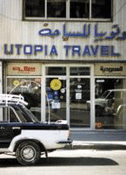
A Journey in Search of (post)modern Utopia
Utopia Travel is a collaborative project by Austrian Artists David Rych and Emanuel Danesch. The basis of the project is the transport of a video collection from Cairo to Vienna, following the transition from the upper part of the African continent over the Middle East towards Europe. An Egyptian taxi equipped with a video monitor served as a mobile unit distributing the contents of the video-archive on the distances between the capitol cities of the respective countries.
The title of the project was taken from the name of a travel agency in Cairo, which befittingly alluded to the ironic circumstance that tourism offers a temporary utopia of exoticism in various directions, whilst discovering no more than just a transmitted fragment of another culture. The archive contains pre-selected video material produced by artists/ film directors originating from and in most cases living in one of the countries on the route.
Every single videotape is labelled with the name of the author and title of the work. The only indication marking region on the label, is a colour code, created by melting the colours of every national flag into one. Since in certain regions (like the states of former Yugoslavia) the colours of neighbouring nations remain quite similar, differences are visible only in very subtle nuances; this makes people guess the precise origin of a work, even if the basic region was quite obvious. The method of presentation provided the opportunity to touch on a variety of issues, from the complexity of individual societies to the construction of political territories. In that sense the project is understood to be a temporary, non-institutional platform focusing on the translation and transmissibility of local cultural codes as different aspects of interrelated history.
The Archive was shown in the taxi as a mobile video installation on a three and a half months long tour through the cities Cairo, Beirut, Istanbul, Sofia, Belgrade, Sarajevo, Zagreb, Ljubljana, Graz and Vienna. The presentations took place to a large extent in public space, while also docking to different institutions for art and culture.
Posted by jo at 10:04 AM | Comments (0)
August 01, 2004
Distributed Opera
The BRAIN OPERA
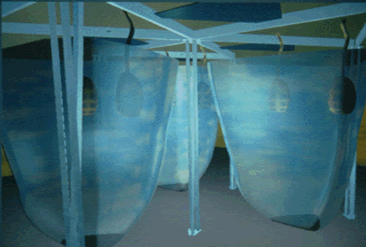
Premiered in 1996, this interactive, musical journey was presented simultaneously in physical and cyber space. A viewer could perform live in the Brain Opera performances via " T h e P a l e t t e," musical instrument. This advanced, multi-user Java applet, was only active during Brain Opera performances. You could also see and hear live video and audio broadcasts of the Brain Opera performances.
The culmination of the Brain Opera experience was the 45-minute Final Performance--a 3-movement composition tied together the project's many musical, visual, and textual strands into a unified tapestry. Three performers shape, select, and interpret precomposed and audience-created elements, using specially-designed hyperinstruments: the Sensor Chair (which translates wireless body movement into sound); the Gesture Wall (a modification of the same instrument from the Mind Forest); and the Digital Baton (which combines pointing, squeezing/selecting, and motion sensing). A large curved screen and multiple projectors allows a constant flow of images to be presented in coordination with the music, illustrating Minsky's words, providing counterpoint to the music, or illuminating the actions of the performers. The audience is also invited to dance on a Sensor Carpet during the Finale, adding sound to the richness and intensity at the end of the work.
Posted by michelle at 04:51 AM
July 31, 2004
More Distributed Cinema
Lev Manovich's Soft Cinema
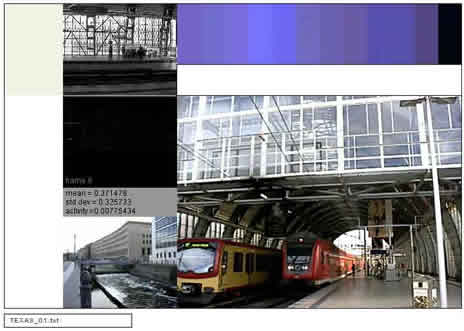
Soft(ware) Cinema is a dynamic computer-driven media installation. The viewers are presented with an infinite series of narrative films constructed on the fly by the custom software. Using the systems of rules defined by the author, the software decides what appears on the screen, where, and in which sequence; it also chooses music tracks. The elements are chosen from a media database which at present contains 4 hours of video and animation, 3 hours of voice over narration, and 5 hours of music.
Affective
Cinema
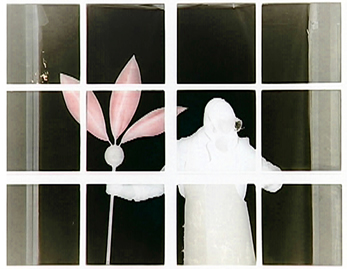
Affective Cinema is an interactive video installation. The order and parameters of image and sound shown on the video are influenced according to the visitor’s measured emotional response to displayed video clips. Players see more important video scenes; the stronger they react, the more they understand of a secret system, where abstract characters and objects tell a situation of social dependencies and connections. There is an abstract spatial situation: only elements like windows, doors, cars, etc. are placed in a wide unlimited white space – no walls or environmental elements. The sound has the important function to create that space in the human mind and to cause additional emotional reactions.
Posted by michelle at 07:16 PM
Mobile Culture-Scratching

by Julie Andreyev, at New Forms Festival 2003, consists of 3 cars fitted with video projection on the rear windshield. Each car has a theme determined by the character of the car, and by characteristics of the host city where the fleet is mobilized. The choice of cars for the project reflects the specific car culture of the host city expressed through customization and branding.
Mobile Equipment
The cars are set up with equipment to allow for mobile video downloading, and video mixing using data from the car. While the fleet is mobile, videographers in the downtown site are creating videos for projection on the cars. The themes are used as a guide for them to create footage of the activities of a city's inhabitants.
Networked Process
This footage is uploaded by the videographers onto a web server. Then, the footage is downloaded by the cars as they drive by WIFI (wireless internet) download sites. A sound artist records ambient sound using a microphone held outside the window of one of the cars, mixes this, and plays it back using an FM transmitter. Nearby cars can tune into our frequency and hear the audio sampling. Each car is equipped with a sensor and software patch that interprets data from the car.
Software Interface
For example, one sensor reads data from the engine speed. This data causes a kind of 'jittery' effect to be applied to the video. The faster the car revs, the more 'jittery' the video. In this way, not only are the inhabitants of the city portrayed, but also the car is expressed in the video. After the performance, the cars can be driven into a gallery space where they can be set up to project their archive of the evenings' videos.
Mobile Portrait of the City
The goal of this project is to create a mobile portrait of the city through video and audio sampling of real time events. VJ-Fleet relies on current VJ (or video jockey) culture and the hosting city's local car and social culture. For each performance the project is customized and scaled to reflect the particular nature of the host city.
Posted by michelle at 06:37 PM
July 30, 2004
Networked Local Performances
Three Performances: 2001-03: A Comment
The three location-specific performances Dialtones: A Telesymphony, Flip Flop, and Texterritory --you had to be there to experience them--introduced in the last posts were produced between 2001 and 2003 They made use of networked technologies--mobile phones, video/audio relayed by wireless broadband--to involve their audiences in the creation of the performances. Each has done this successfully in its own way, while maintaining control, in the case of Dialtones, a tight control, over the performance itself.
Posted by newradio at 10:06 AM | Comments (0)

